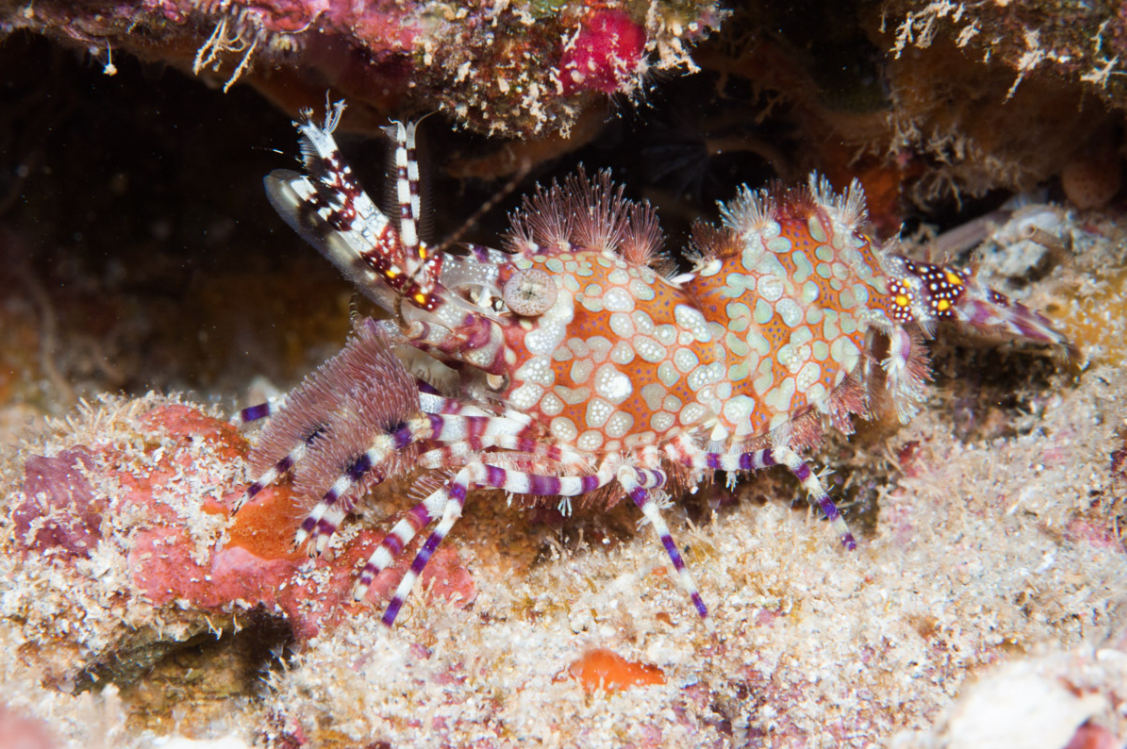Saron shrimps are a common sight on Indo-Pacific reefs, found lurking within rocky crevices during the day and emerging at night to forage and fight amongst themselves. Little is known of their ecology and behavior, but they are typically solitary and presumably territorial, with males developing a pair of grotesquely elongated legs used for bouts of ritualistic combat.
Thanks to their clown-like colors and patterns, these shrimps are frequently collected for the aquarium trade as an unusual (and somewhat untrustworthy) addition to reef tanks, but the bewildering diversity of color morphs seen within this group has long stymied efforts at classifying the genus. There has yet to be any meaningful taxonomic investigation of the group; however, a recent molecular study (Baeza et al 2022) confirms what has long been known… there are many, many undescribed species hiding in plain sight.
If you’ve ever cracked open a field guide on this subject, you’ll be met with varied opinions as to how many species actually exist, where they occur, and what diagnostic traits can be used to identify them. The current classification recognizes only 4 species—marmoratus, neglectus, inermis, rectirostris—with the latter 2 species having been described in the 1980’s and referring to easily identified phenotypes. On the other hand, marmoratus and neglectus are older names whose true identity remains unsettled in the absence of a taxonomic revision.
The description of marmoratus dates to 1811 and is based on material from Shark Bay, Western Australia that was collected during the famed Baudin Expedition (one of the earliest European studies of Australia’s coastal ecosystems, which resulted in the discovery of many hundreds of new species), but this bay is known to be home to at least 2 similar species, either of which might plausibly be referenced in the brief descriptive notes, and, adding to the confusion, the holotype no longer exists. Thus without a new type specimen being assigned, we can’t even confidently use this name, and so we will instead be referring to a marmoratus complex. The same is equally true for neglectus, described in 1902 from Ternate, Indonesia, as this taxon could also apply to one of several similar species within a diverse neglectus complex.
The following guide is based on photographed specimens from throughout the Indo-Pacific, though many regions and species remain very poorly documented, sometimes with only a single photo or two available. The species indicated here are largely congruent with those proposed in the molecular examination of Baeza et al 2022, though several additional species unexamined by those authors are included here for the first time. Whereas the traditional classification of Saron recognizes just 4 valid species and the Baeza phylogeny indicates ~13 species, this guide identifies at least 28 (twenty-eight!) species, illustrating just how much taxonomic work lies ahead of us.
The most important visual clues for identification purposes are those that are anterior-facing, and thus likely to be used by the shrimps to recognize one another when they meet on the reef, most notably the color patterning of the antennal segments (specifically, the basicerite & scaphocerite), but also the color patterns of the cephalothorax (“carapace”), pleon (“abdomen”), and the pleopods (“swimmerets”). Coloration of the maxillipeds (the leg-like mouthparts) & pereopods (the walking legs) is informative for recognizing the major lineages within this genus, whereas coloration of the maxilliped setae (“hairs”) and the relative length of the male’s elongated 1st pereopods can be useful for delimiting species within these complexes. It warrants emphasis that it is the color patterns that are of diagnostic importance, as the colors themselves are prone to significant intraspecific variation; also note that nocturnal colors are often different from the diurnal colors, giving a distinctly red or red-banded appearance, and in some instances obscuring elements of the patterning (e.g. large blotches disappearing or small vacuoles appearing).
Data points indicated on the maps are based exclusively on specimens identified from photographs, as existing locality records are inherently untrustworthy; speculative distributions for these species are indicated in red. Lastly, I’ll be making an effort here to establish a new naming system for these shrimps, as the hodgepodge of competing common names found in various field guides are too inconsistently applied to be of much use. With that said, let’s begin…
The marmoratus complex
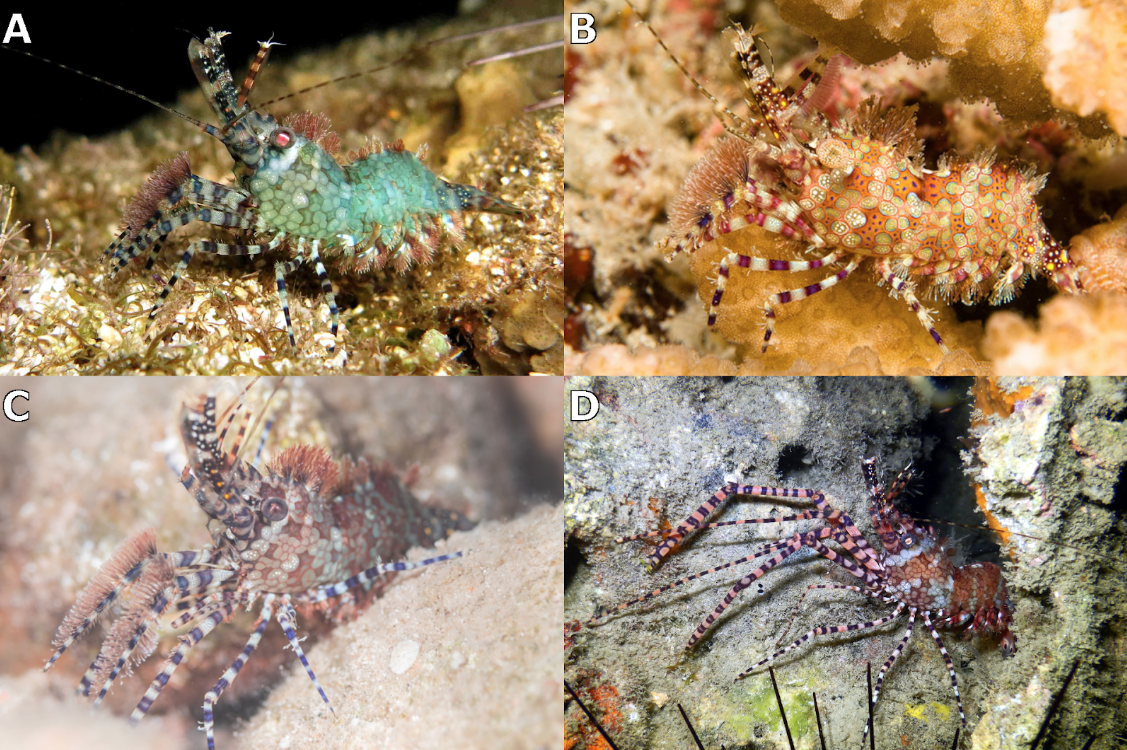
Credit: A: Reunion (Jean-Marie Gradot); B: Hawaii (Chuck Babbitt); C: Aqaba (Itai Grisaru); D: Kenya (Ewout Knoester)

Common Name: Red-haired Marbleshrimp
Identification: Carapace & pleon with irregular red blotches separated by smaller, white-pigmented vacuoles. 2nd pleonite with a medial white spot; 3rd pleonite sometimes with paired white spots. 5th & 6th pleonites with dark streaks covered by white & yellow dots. Pereopods purple-banded. Maxilliped setae reddish. Scaphocerite dark basally, with fine white & yellow dots; apically with 2 dark bands. Basicerite with 1 large, elongate pale spot. Male 1st pereopod greatly elongated.
Notes: This is the most widespread of the Saron shrimps and, along with the Vacuolated Marbleshrimp, is one of the plausible candidates for the marmoratus description, having been documented from Shark Bay. These 2 species are easily confused, as both feature a heavily vacuolated pattern; coloration of the maxilliped setae (red vs white), pereopod bands (purple vs green), basicerite pattern (1 spot vs 2 spots), and male pereopod length (long vs short) are useful diagnostic traits. Occasional specimens are more green than red, and nocturnal colors change to a red carapace and red-banded pleon.
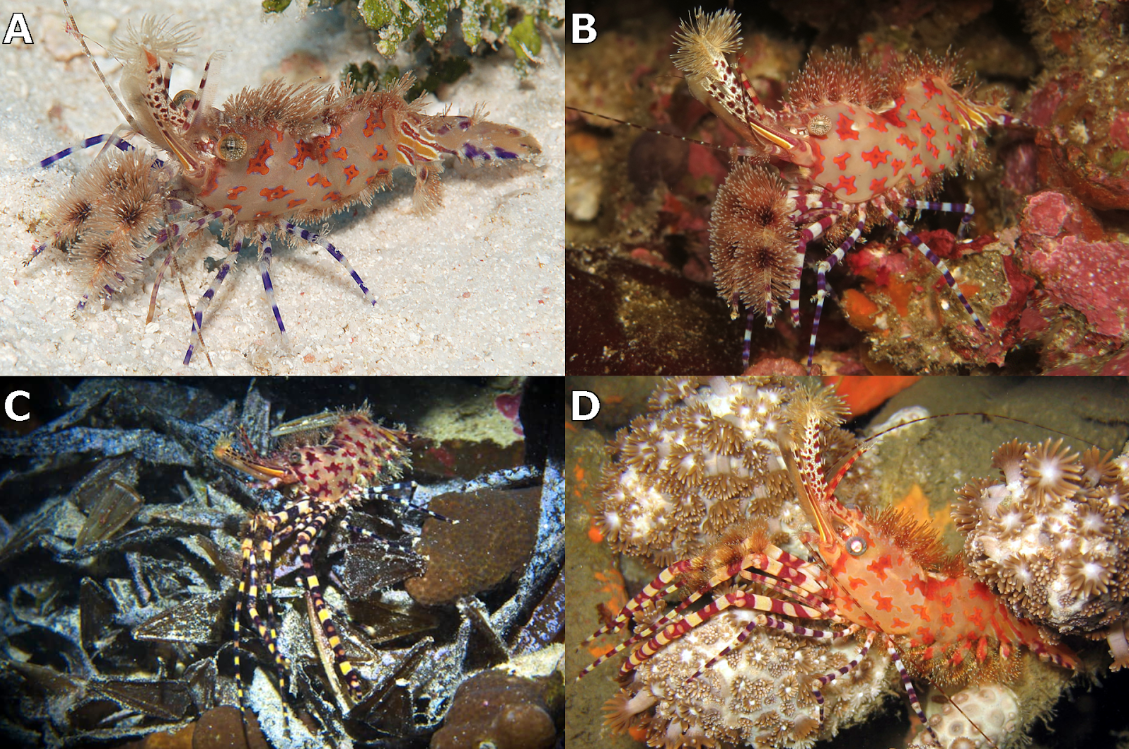
Credit: A: Kwajalein (Scott Johnson); B: Alor (Iain Fraser); C: Tanzania (Sarah Schrey); D: Togean Islands (Sylvain Le Bris)
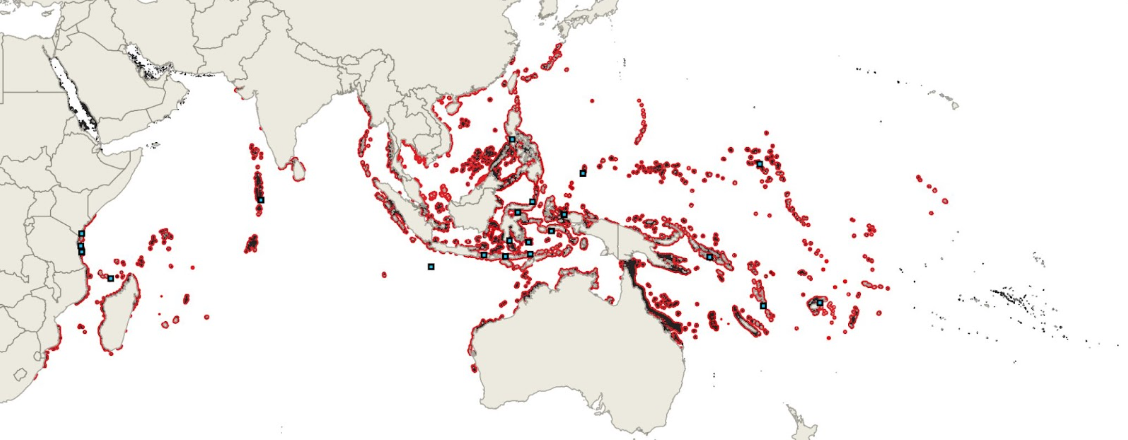
Common Name: Bushynose Marbleshrimp
Identification: Carapace & pleon colorless, with irregular red blotches, often blue on the interior. 2nd pleonite with a medial white spot. 5th & 6th pleonites with diagonal red stripes and often yellowed in-between. Pereopods purple-banded. Maxilliped setae white. Scaphocerite with a prominent yellow streak. Basicerite mostly pale, with purple margin. Male 1st pereopod greatly elongated. Rostrum with a distinctive tuft of setae apically.
Notes: The bushy tip of the rostrum is unique with the genus. Generally an uncommon species from deeper reef slopes.
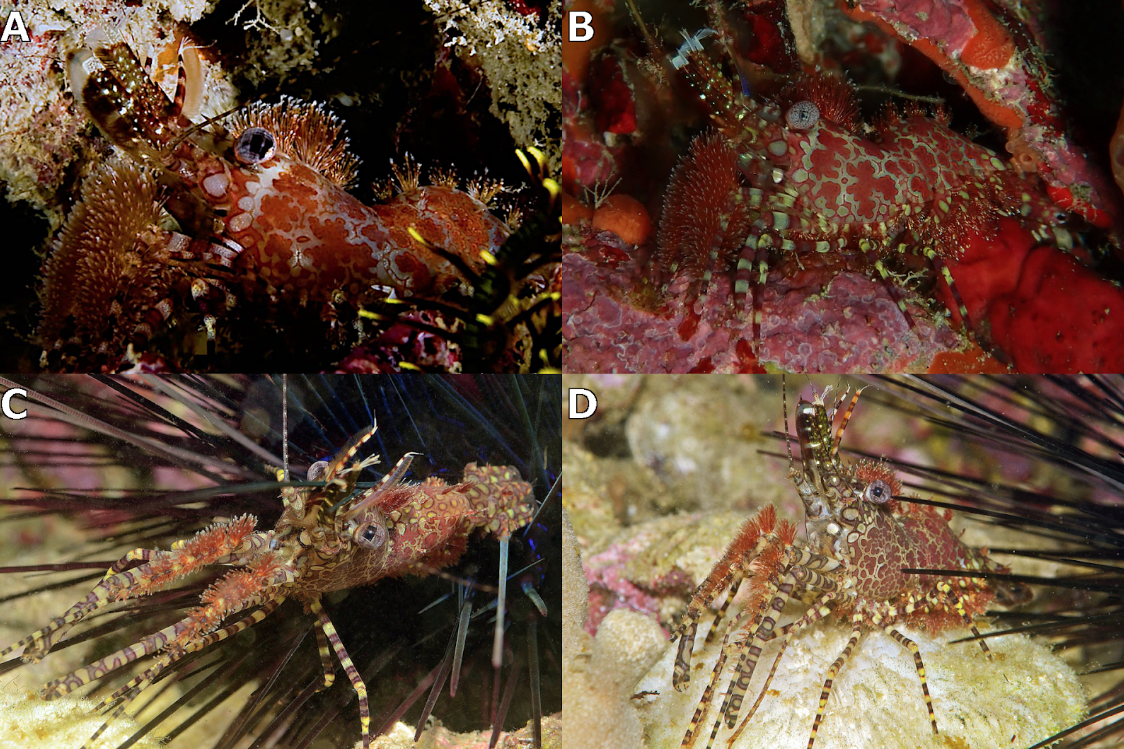
Credit: A: Derawan Islands (Hendra Tan); B: Semporna (Daniela Kupschus); C: Anilao (Scott Johnson); D: Anilao (Scott Johnson)
Common Name: Amoeboid Marbleshrimp
Identification: Carapace & pleon densely covered with irregular (vaguely amoeboid) red blotches. 2nd pleonite with a medial white spot; 3rd pleonite with 4 white spots arranged in pairs. 5th & 6th pleonites with yellow spots. Uropods with yellow spots. Pereopods yellow, with dull-purple bands. Maxilliped setae red. Scaphocerite dark, with white dots encircled by dark lines. Basicerite with 1-2 large pale spots. Male 1st pereopod greatly elongated.
Notes: The Amoeboid, Half-spotted, Pocked, and Caledonian Marbleshrimps comprise an allopatric clade within the marmoratus complex diagnosed by varying combinations of amoeboid and spotted patterns on the carapace and pleon. These appear to be limited to deeper reef slopes and walls.
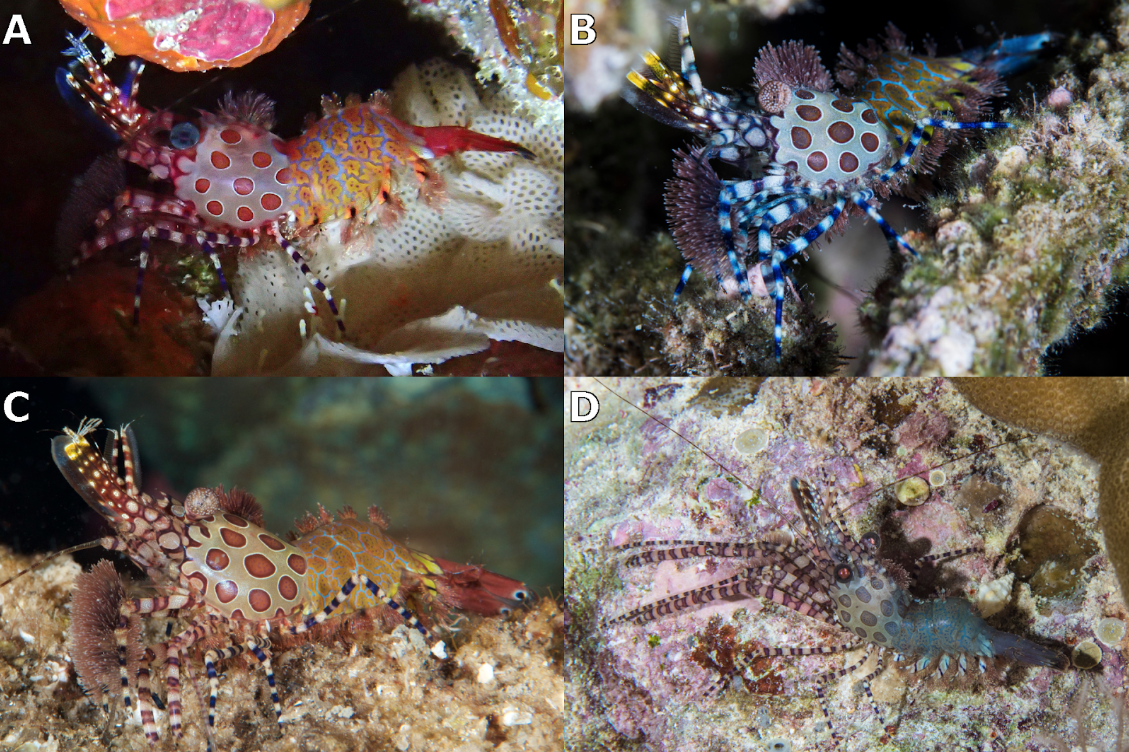
Credit: A: Maldives (Albert Kang); B: Fiji (Luke Gordan); C: Alor (Rene Cazalens); D: Solomon Islands (Mark Rosenstein)
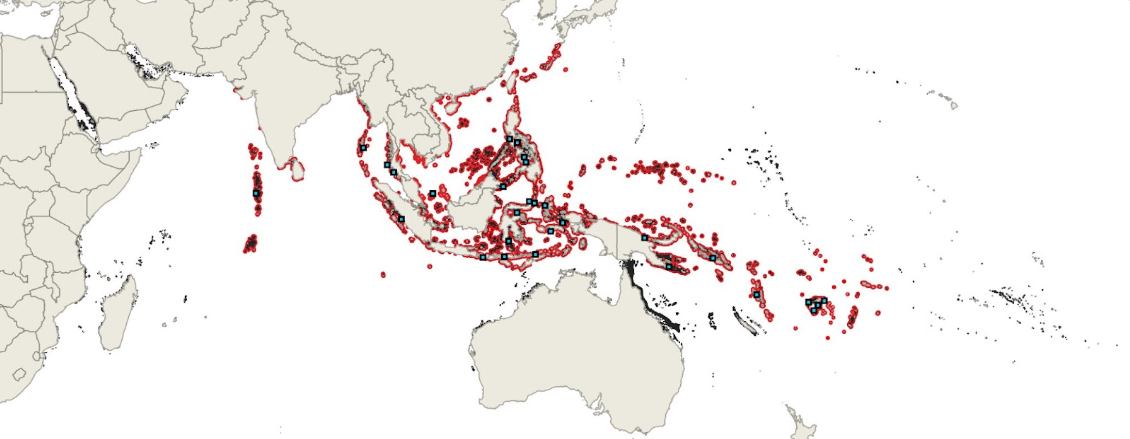
Common Name: Half-spotted Marbleshrimp
Identification: Carapace sparsely covered with large symmetrical red spots. Pleon bright blue or pale grey, with amoeboid spots. 2nd pleonite with a medial white spot; 3rd pleonite with 4 white spots arranged in pairs. 5th & 6th pleonites without yellow spots, turning red posteriorly. Uropods without spots, often red. Pereopods white, with purple bands. Maxilliped setae red. Scaphocerite dark, with white dots encircled by dark lines. Basicerite with 2 adjoined spots. Male 1st pereopod greatly elongated.
Notes: Given the pervasive allopatry within the “polkadot clade”, the broad distribution of the Half-spotted Marbleshrimp may be hiding additional cryptic species, though the phenotype is remarkably similar across its range, from the Maldives to Fiji. This species is on the cover of Humann & Deloach’s popular field guide Reef Creature Identification Tropical Pacific.
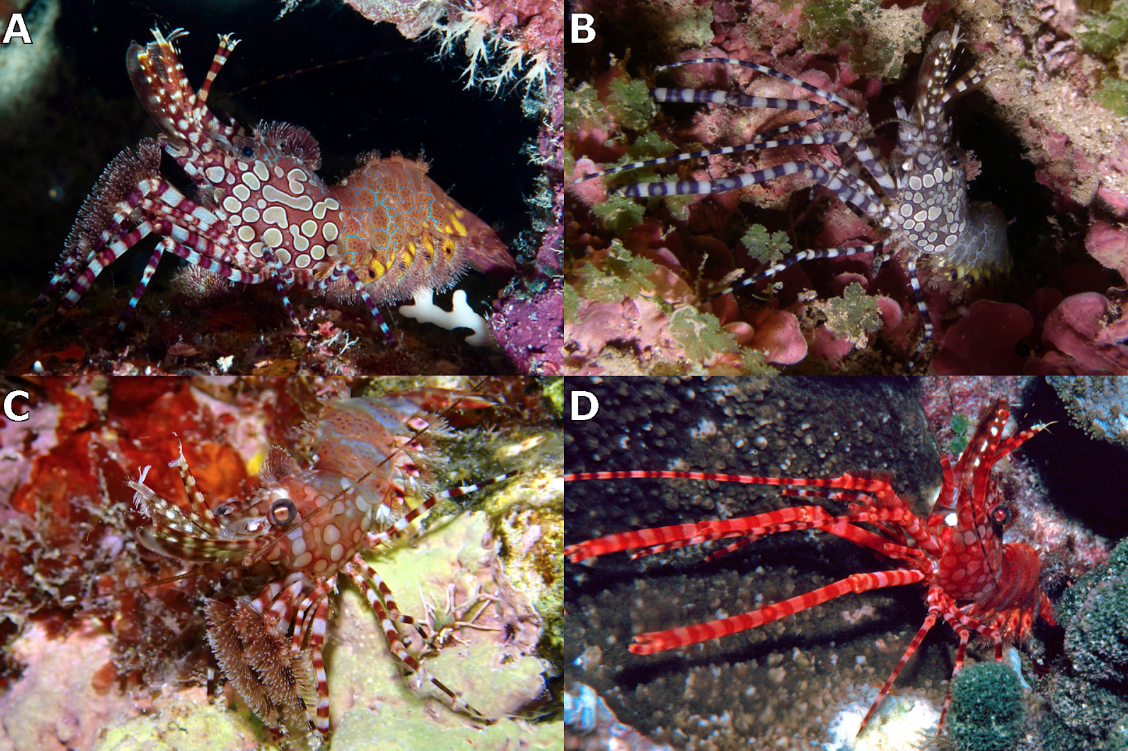
Credit: A: Great Barrier Reef (Emma Brown); B: Guam (Dave Burdick); C: Saipan (Emilie Kohler); D: Kwajalein (Scott Johnson)
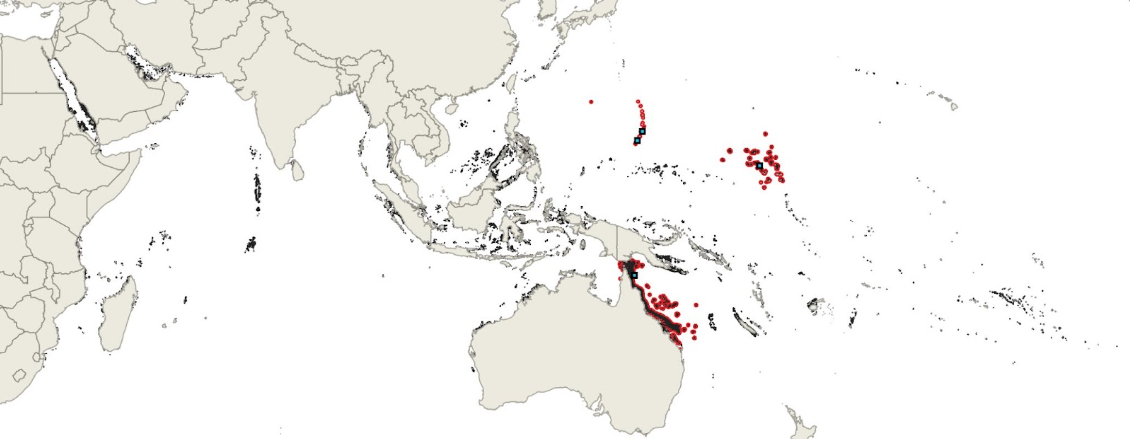
Common Name: Pocked Marbleshrimp
Identification: Carapace densely covered with large irregularly shaped pale spots, giving a pocked appearance. Pleon bright blue or pale grey, with amoeboid spots. 2nd pleonite with a medial white spot; 3rd pleonite with 4 white spots arranged in pairs. 5th & 6th pleonites with indistinct yellow markings, turning red posteriorly. Uropods without spots, often red. Pereopods white, with red-purple bands. Maxilliped setae red. Scaphocerite dark, with white dots encircled by dark lines. Basicerite with 1-2 large pale spots. Male 1st pereopod greatly elongated.
Notes: There may be 3 distinct species sharing the “pocked” phenotype, endemic to the Mariana Arc, the Marshall Islands, and Queensland. The latter is notably disjunct from the northern populations, with the Half-spotted Marbleshrimp occurring throughout Melanesia. Populations elsewhere in Micronesia are undocumented.
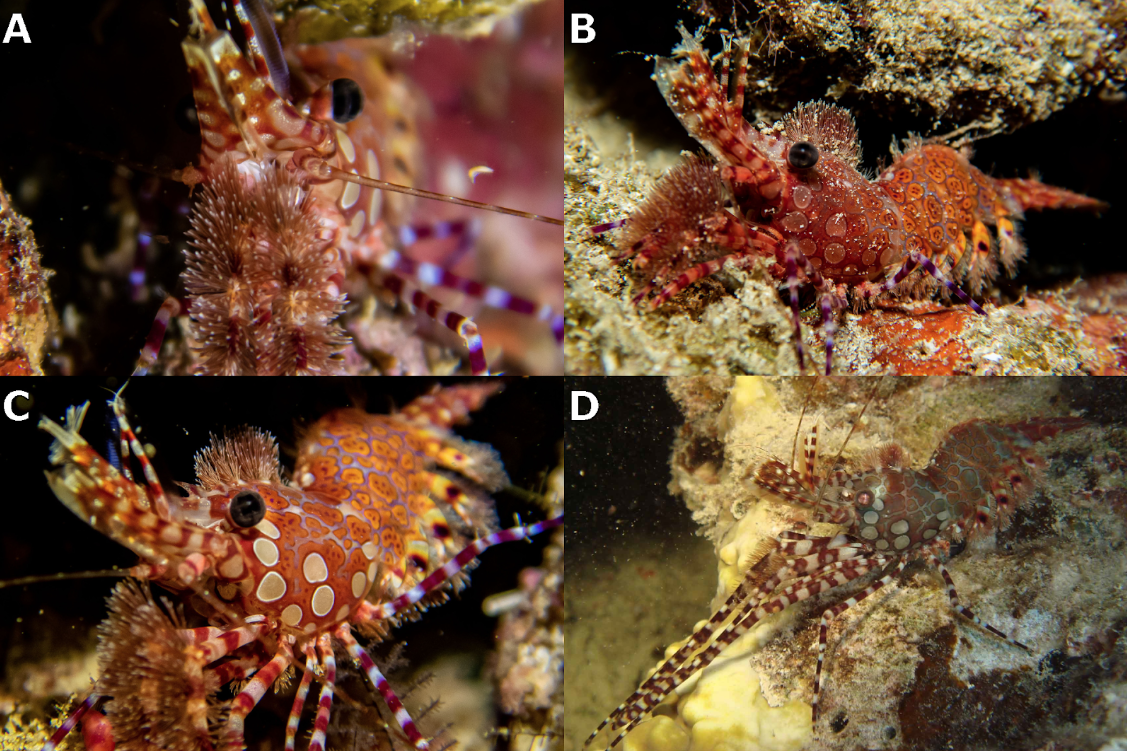
Credit: A: New Caledonia (Pauline Fey); B: New Caledonia (Pauline Fey); C: New Caledonia (Pauline Fey); D: New Caledonia (juju98)
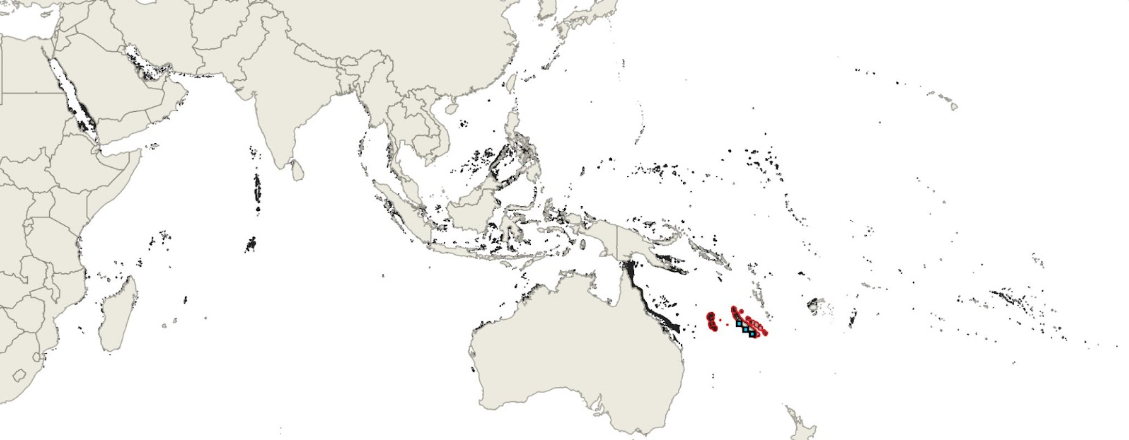
Common Name: Caledonian Marbleshrimp
Identification: Carapace ventrally with large symmetrical pale spots atop a background pattern of red amoeboid spots. Pleon bright blue or pale grey, with amoeboid spots. 2nd pleonite with a medial white spot; 3rd pleonite with 4 white spots arranged in pairs. 5th & 6th pleonites without yellow spots, turning red posteriorly. Uropods without spots, often red. Pereopods white, with purple bands. Maxilliped setae red. Scaphocerite red, with large white spots. Basicerite with 1-2 large pale spots. Male 1st pereopod greatly elongated.
Notes: A distinctive member of the polkadot clade that appears to be endemic to New Caledonia.

Credit: A: Raja Ampat (Yawzer); B: Togean Islands (Greg James Wade); C: Togean Islands (Sylvain Le Bris); D: Raja Ampat (Dustin Harrington)
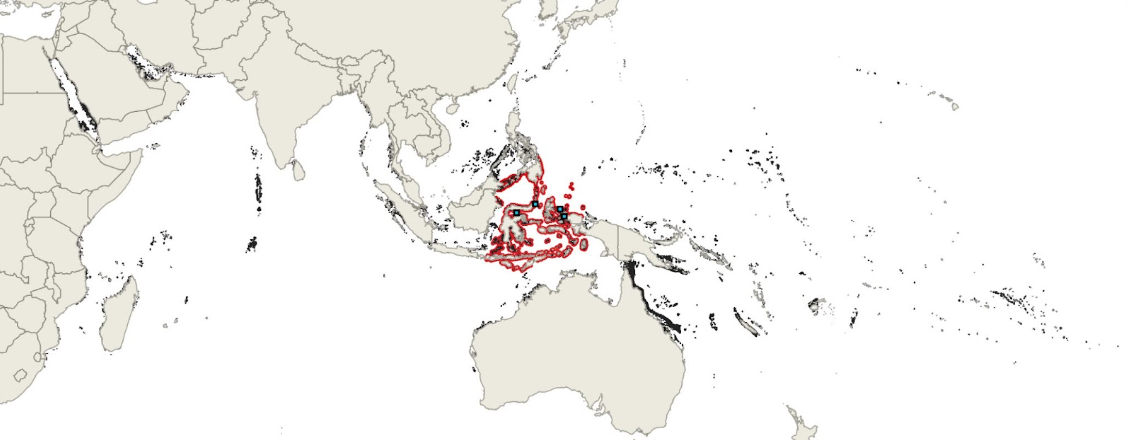
Common Name: Reticulated Marbleshrimp
Identification: Carapace & pleon red or grey, with a dense network of pale or greenish reticulating lines. 3rd pleonite with a pair of large white spots dorsally. 5th & 6th pleonites with paired black & blue spots. Pereopods purple-banded. Maxilliped setae red. Scaphocerite dark, with a few white dots. Basicerite pale, with a few bold white lines, with matching lines extending onto the anterior portion of carapace. Male 1st pereopod greatly elongated, with 5 green double-bands and narrow white interspaces.
Notes: A distinctive species known from only a few localities in West Papua and Northern Sulawesi, but perhaps more widespread in the Banda Sea. The densely banded male pereopod is more akin to that of the neglectus complex, but otherwise the coloration is typical of the marmoratus complex—this chimeric mixture of phenotypic traits may hint at a basal position within the genus, but molecular data is lacking.
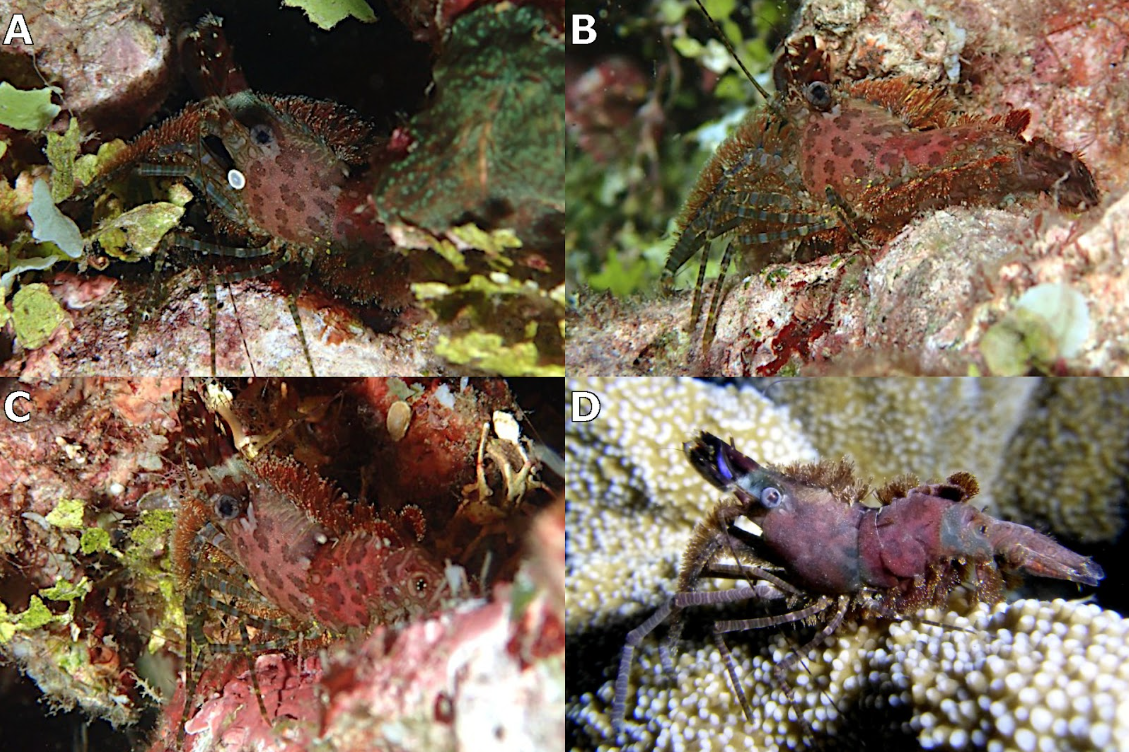
Credit: A: Coron (omibluesea); B: Coron (omibluesea); C: Coron (omibluesea); D: Coron (Kai Squires)
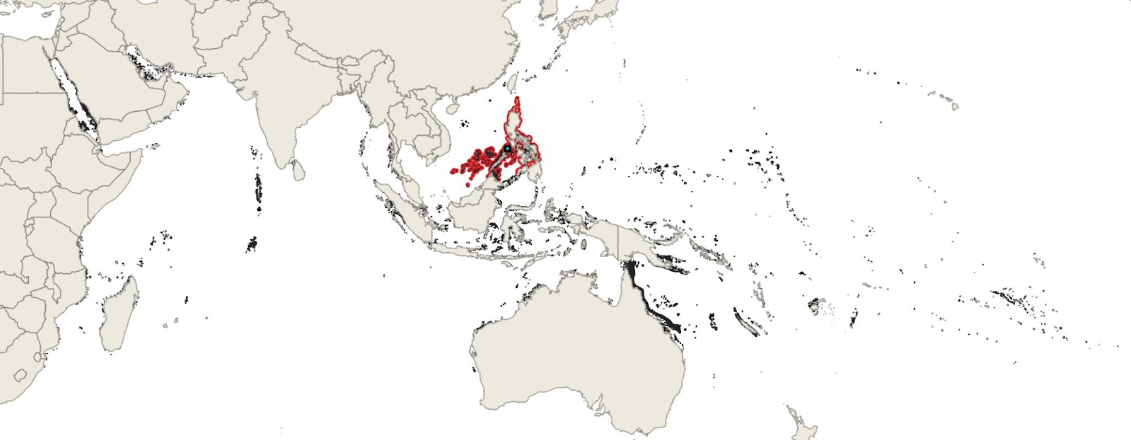
Common Name: Coron Marbleshrimp
Identification: Carapace & pleon reddish, with several irregular dark-red blotches. 3rd pleonite with a pair of large white spots dorsally. 5th & 6th pleonites with paired black & blue spots. Pereopods with dark bands. Maxilliped setae red. Scaphocerite dark, with a few white dots. Basicerite pale, with 2 pale spots. Male 1st pereopod greatly elongated, with 5 green double-bands and narrow white interspaces.
Notes: This is a northern sister species of the Reticulated Marbleshrimp, differing in the blotchy (vs reticulated) pattern of the carapace. Specimens are known only from Coron, but might be expected elsewhere in the Philippines.
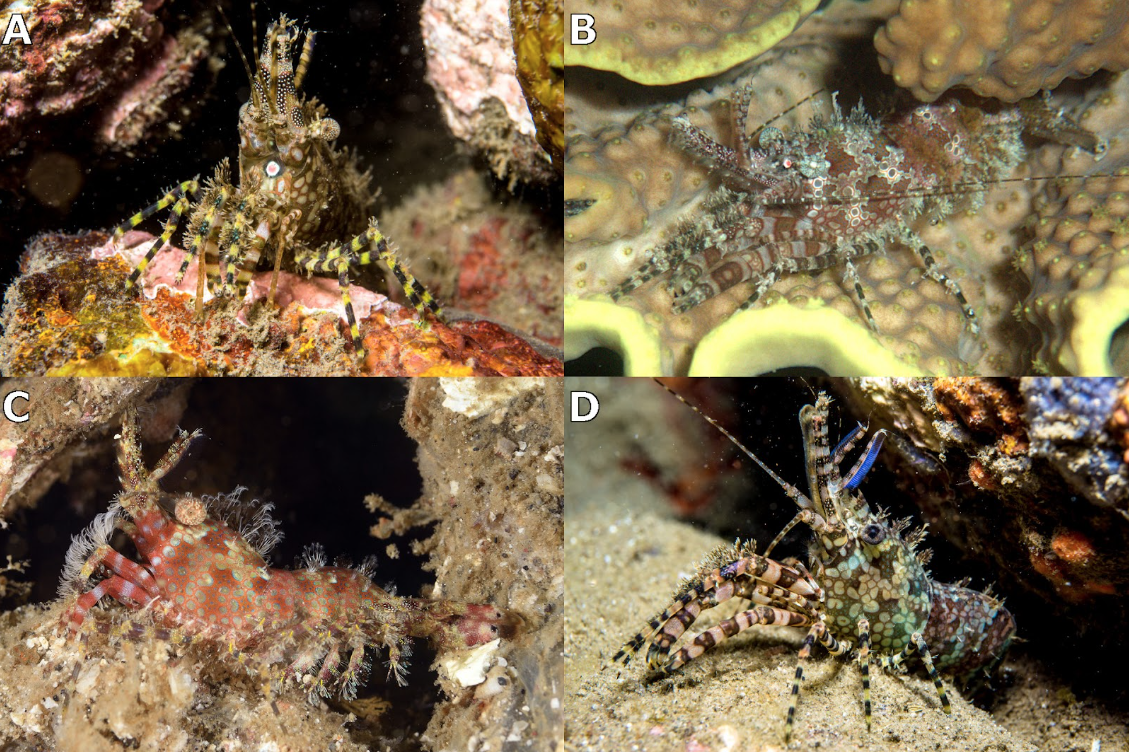
Credit: A: Bali (Frank Spies); B: Austral Islands (tahiticrabs); C: Lembeh (Terence Zahner); D: Bali (Frank Spies)
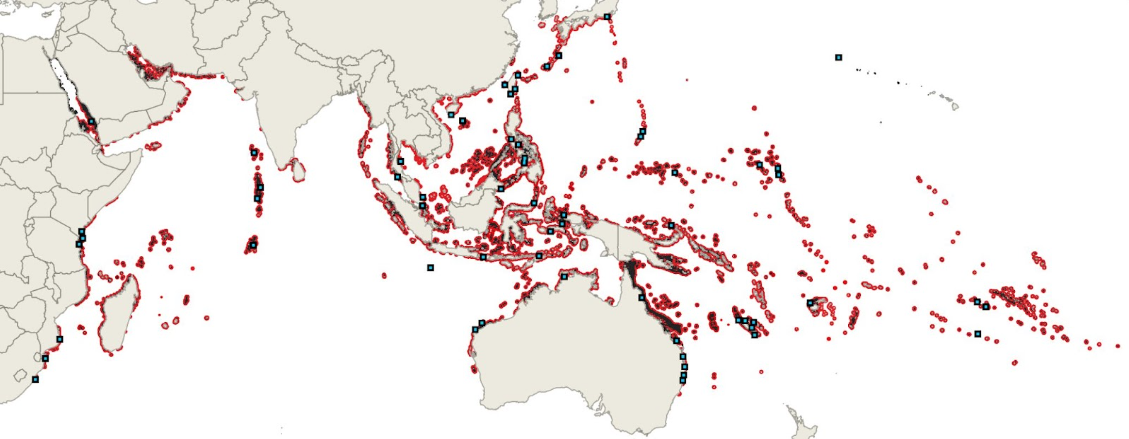
Common Name: Vacuolated Marbleshrimp
Identification: Carapace & pleon with irregular red or green blotches separated by smaller pale vacuoles (mostly without white pigmentation; some of these may have a distinct orange ring, with such ringed vacuoles arranged into several distinct lines). 5th & 6th pleonites with dark streaks covered by white & yellow dots (often this pattern is obscured by a secondary opaque pattern overlaid atop it). Pereopods bands green or dark, rarely appearing purple. Maxilliped setae white. Scaphocerite dark basally, with fine white & yellow dots; apically with 2 dark bands. Basicerite with 2 pale spots. Male 1st pereopod stout, not greatly elongated.
Notes: This is a relatively widespread species, but is notably absent from the Northern Red Sea and Hawaii. Along with the Red-haired Marbleshrimp, it is one of the plausible candidates for the marmoratus description, having been documented from Shark Bay. These 2 species are easily confused, as both feature a heavily vacuolated pattern; coloration of the maxilliped setae (white vs red), pereopod bands (green vs purple), basicerite pattern (2 spots vs 1 spot), and male pereopod length (short vs long) are useful diagnostic traits. Compared to the Red-haired Marbleshrimp, specimens are often duller in color, and the species seems to be more frequent in coastal habitats. This latter ecological trait may favor it being the true marmoratus, given its relative abundance in shallow, intertidal habitats.
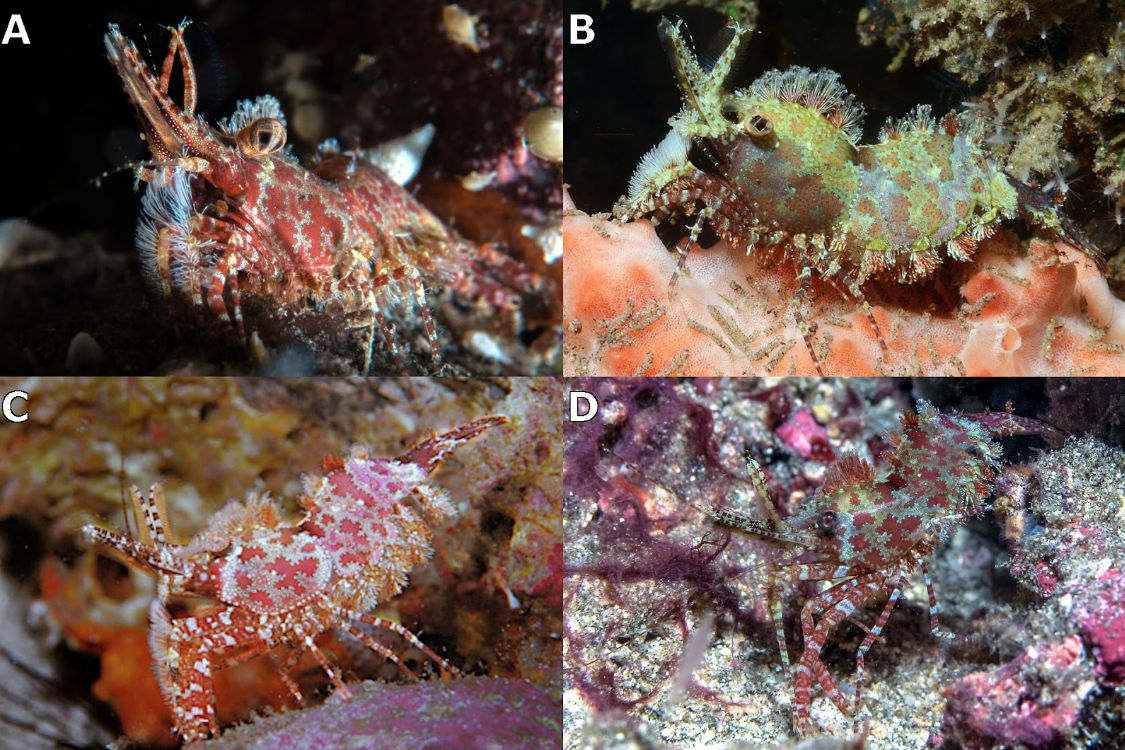
Credit: A: Bali (Michael Bubbles); B: Bali (Scott Johnson); C: Kashiwajima (S. Nakayama); D: Bali (Frank Spies)
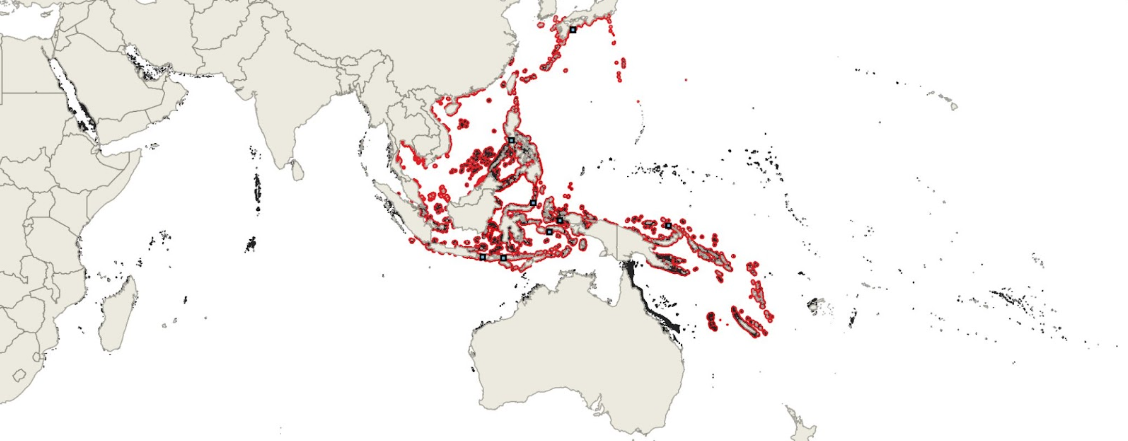
Common Name: Crenulated Marbleshrimp
Identification: Carapace & pleon with irregular red blotches with a crenulate margin, without obvious vacuoles in-between. 5th & 6th pleonites with dark streaks covered by white (but not yellow) dots (often this pattern is obscured by a secondary opaque pattern overlaid atop it). Pereopod bands reddish. Maxilliped setae white. Scaphocerite dark on interior edge, with fine white (but not yellow) dots; the outer edge with numerous dark markings. Basicerite red. Male 1st pereopod stout, not greatly elongated.
Notes: Known mostly from muck sites in the Coral Triangle, but apparently ranging north to Kashiwajima, thus indicating a broader West Pacific distribution than currently known.
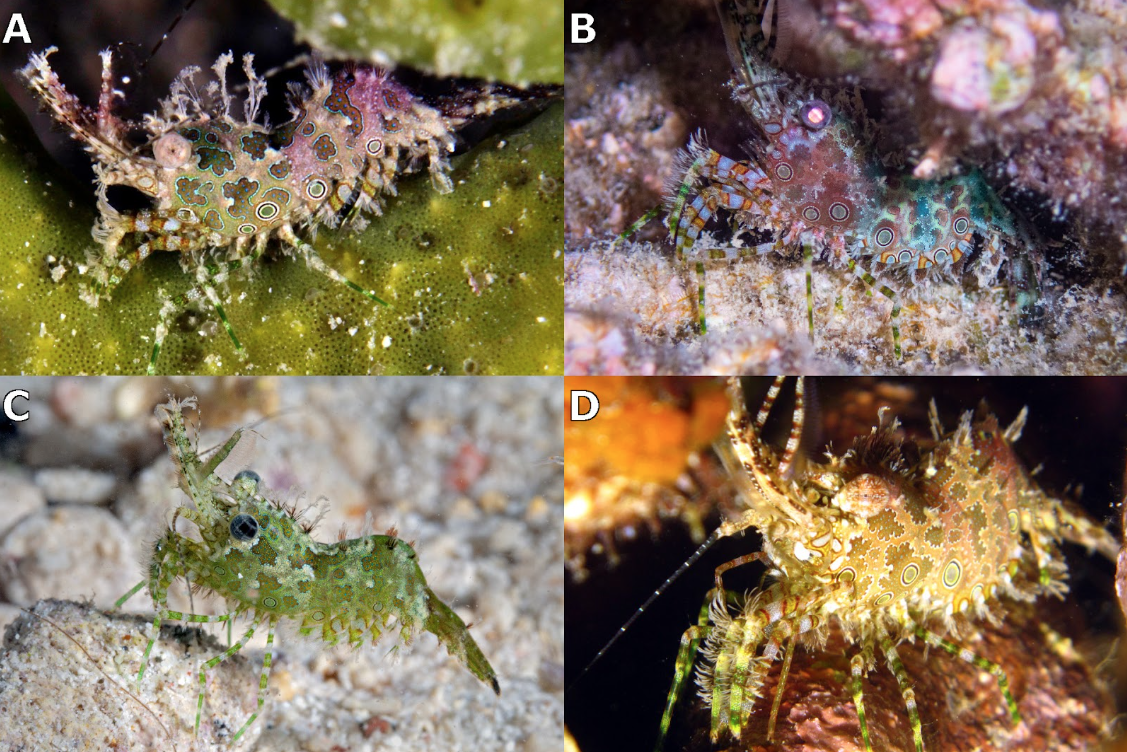
Credit: A: Romblon (Wolfgang Holz); B: New Caledonia (Damien Brouste); C: Lembeh (Jim Greenfield); D: Palau (ruby6_cakap)
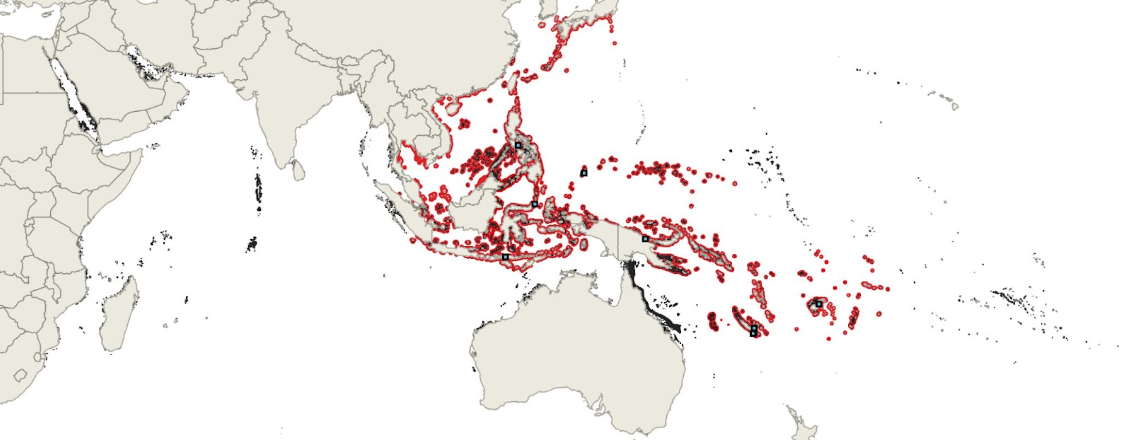
Common Name: Ocellated Marbleshimp Identification: Carapace & pleon with irregular red blotches with a crenulate margin, without obvious vacuoles in-between; several large green ocelli are present near the ventral margin and on the pleopods. 5th & 6th pleonites with dark streaks covered by white (but not yellow) dots (often this pattern is obscured by a secondary opaque pattern overlaid atop it). Pereopod bands green. Maxilliped setae white. Scaphocerite dark on interior edge, with fine white (but not yellow) dots; the outer edge with numerous dark markings. Basicerite with 2 large pale spots. Male 1st pereopod unknown, but likely stout, not greatly elongated.
Notes: Nearly identical to the Crenulated Marbleshrimp, but with a varying number of large green ocelli, green-banded pereopods, and with prominent spots on the basicerite.
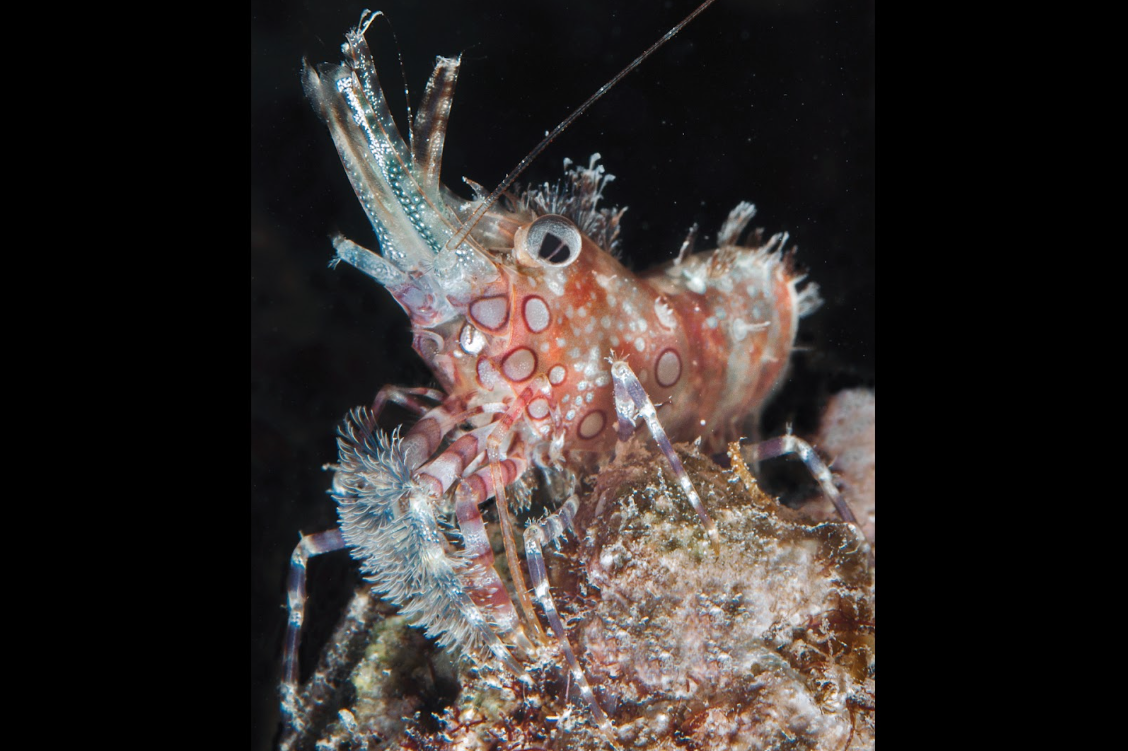
Credit: Fiji (Kareny Honeycutt)
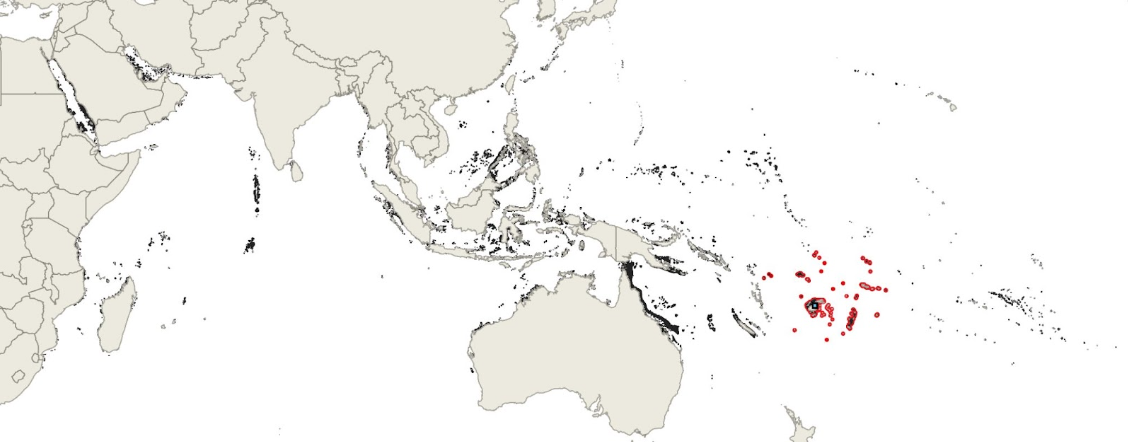
Common Name: Red-ringed Marbleshimp Identification: Carapace & pleon reddish, with numerous small white spots; several large white ocelli are present near the ventral margin. 5th & 6th patterning unknown. Pereopod white with purple bands. Maxilliped setae white. Scaphocerite dark on interior edge, with fine white (but not yellow) dots; the outer edge with numerous dark markings. Basicerite with 1 large pale spot. Male 1st pereopod unknown, but likely stout, not greatly elongated.
Notes: This phenotype is known from a single photo taken in Fiji and closely resembles the Ocellated Marbleshrimp (also known from Fiji), but it differs in having pale ocelli on a reddish background with small white spots, plus purple-banded pereopods. It’s possible these are distinct color morphs of a single species, similar to the intraspecific variation of the Vacuolated Marbleshrimp.
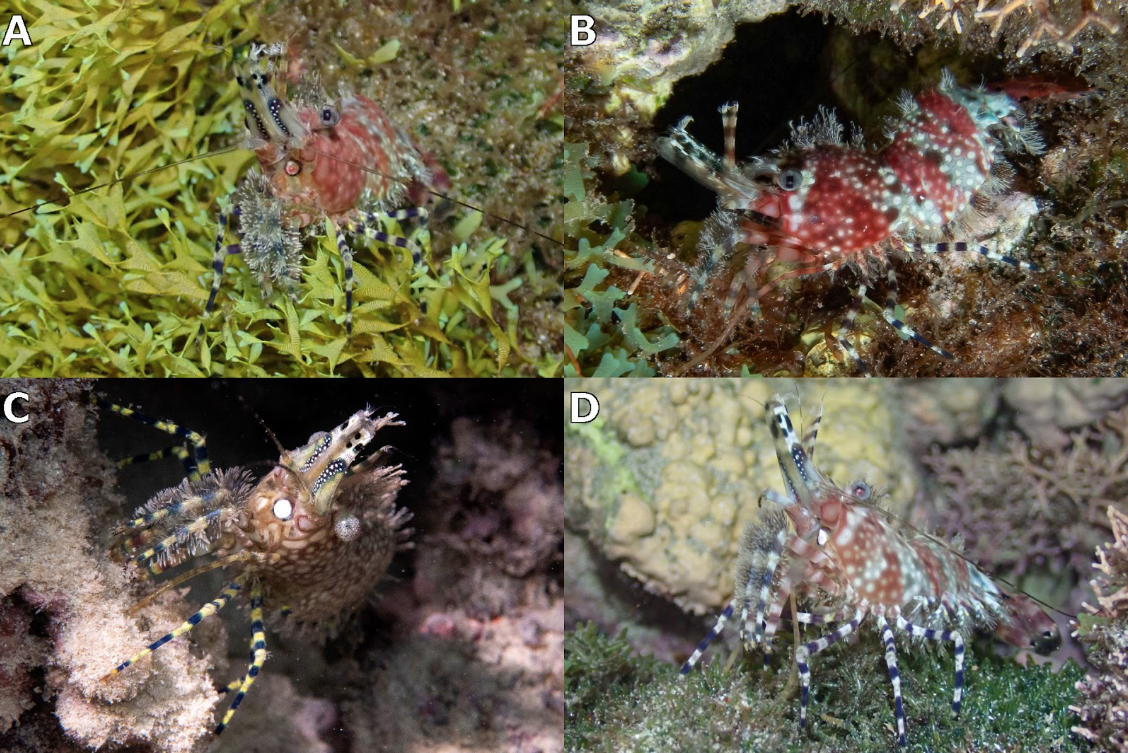
Credit: A: Lord Howe Island (Matt Nimbs); B: Lord Howe Island (Steve Smith); C: Lord Howe Island (John Turnbull); D: Lord Howe Island (Matt Nimbs)
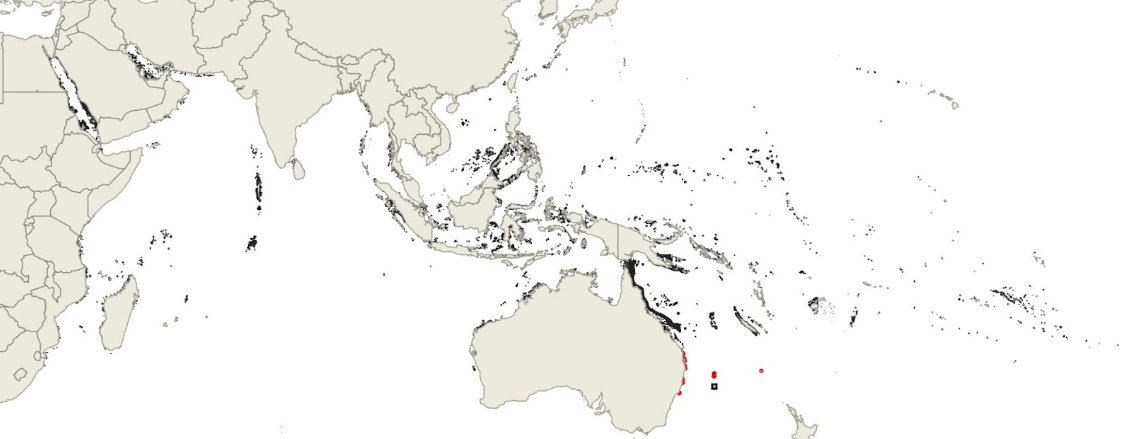
Common Name: Lord Howe Marbleshrimp
Identification: Carapace & pleon reddish, with numerous small white spots. 5th & 6th patterning similar. Pereopod white or yellow with purple bands. Maxilliped setae white. Scaphocerite dark on interior edge, with fine white (but not yellow) dots; the outer edge pale or distinctly yellowed, apically white, with a smiley faced pattern or dark spots. Basicerite with 1 large red-ringed pale spot. Male 1st pereopod unknown, but likely stout, not greatly elongated.
Notes: Very similar to the Red-ringed Marbleshrimp, but lacking ocelli on the carapace and pleon and with a peculiar sideways smiley face marking on the scaphocerite.
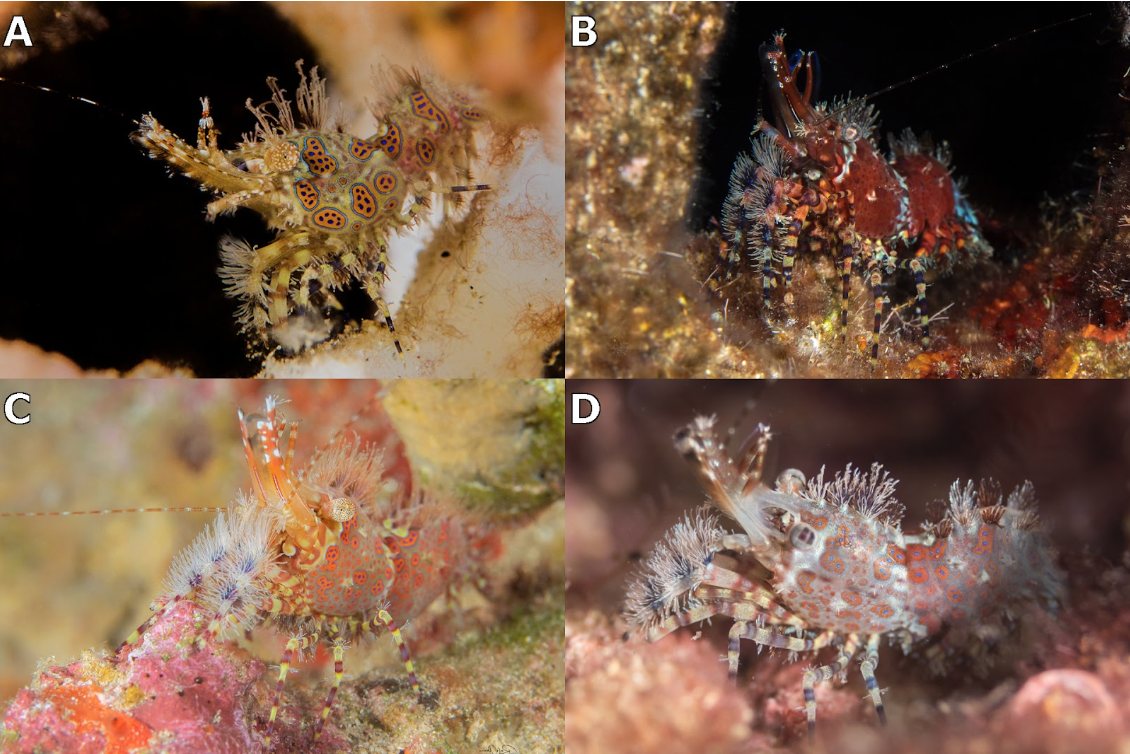
Credit: A: Aqaba (Rafi Amar); B: Israel (Rafi Amar); C: Aqaba (Rafi Amar); D: Aqaba (Itai Grisaru)

Common Name: Aqaba Marbleshrimp
Identification: Carapace & pleon dusky yellow or white, with rounded bright-red blotches sparsely dotted with blue. 5th & 6th pleonites similarly patterned. Pereopods yellow with purple bands. Maxilliped setae white. Scaphocerite with red & white stripe on inner edge, apically with white spots. Basicerite dark, with 2 pale spots. Male 1st pereopod unknown.
Notes: The Aqaba, African, & Arabian Marbleshrimps seem to form a small clade endemic to the Western Indian Ocean diagnosed by a striped scaphocerite, white maxilliped setae, and elongated male 1st pereopods. A population has recently been established in the Eastern Mediterranean Sea as a Lessepsian migrant; the Red-haired Marbleshrimp is, however, unknown to have established itself there, somewhat surprising given its otherwise broad distribution.
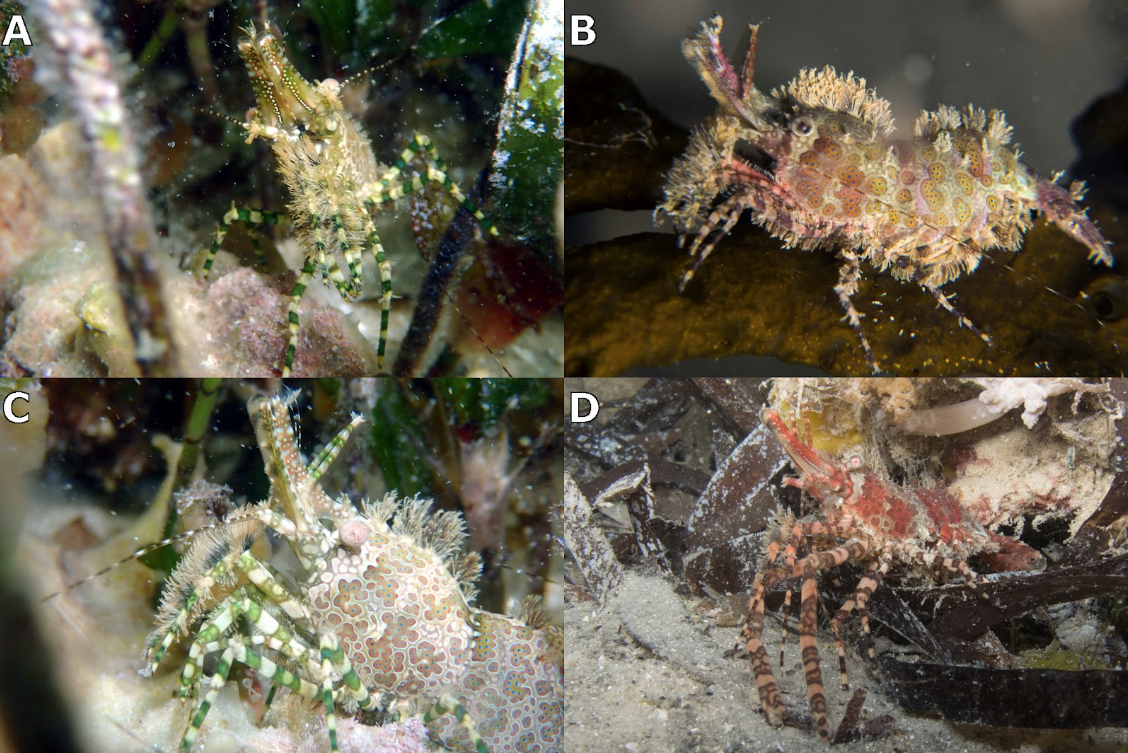
Credit: A: Bazaruto Island (Louw Claassens); B: Kenya (Ewout Knoester); C: Bazaruto Island (Louw Claassens); D: Tanzania (Mafia Island Diving)
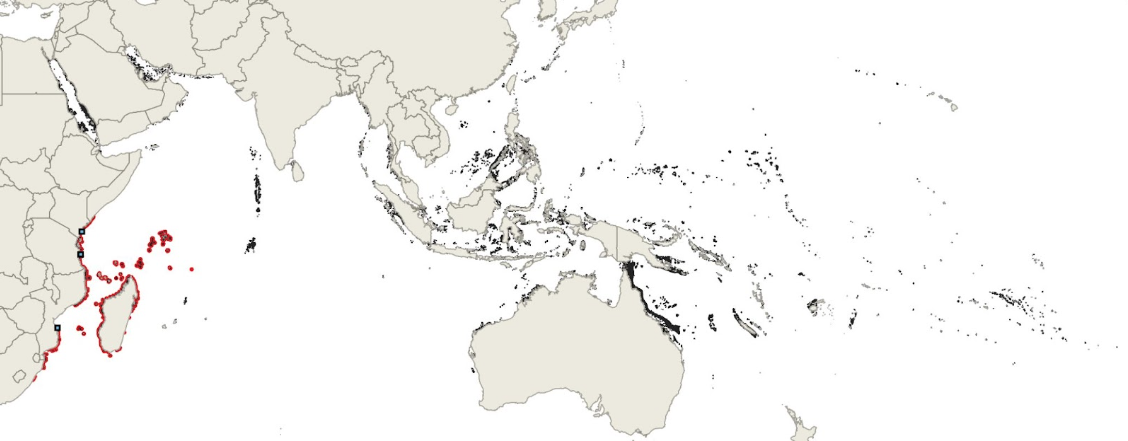
Common Name: African Marbleshrimp
Identification: Carapace & pleon dull in color, with indistinct white spots overlaid by rounded dull-red blotches dotted with blue. 5th & 6th pleonites similarly patterned. Pereopods white with green or darkly colored bands. Maxilliped setae white. Scaphocerite pale or reddish, with incomplete or dotted white stripe on the inner edge, apically with fine white dots. Basicerite weakly patterned, with a small yellowish mark anteroventrally. Male 1st pereopod greatly elongated.
Notes: Easily confused with the Vacuolated Marbleshrimp, but recognized by a distinct scaphocerite patterning and the dense reddish blotches of the carapace and pleon.

Credit: A: Netrani Island (Divegoa); B: Oman (Simmi Gardener); C: Mumbai (Abhishek Jamalabad); D: Mumbai (Abhishek Jamalabad)
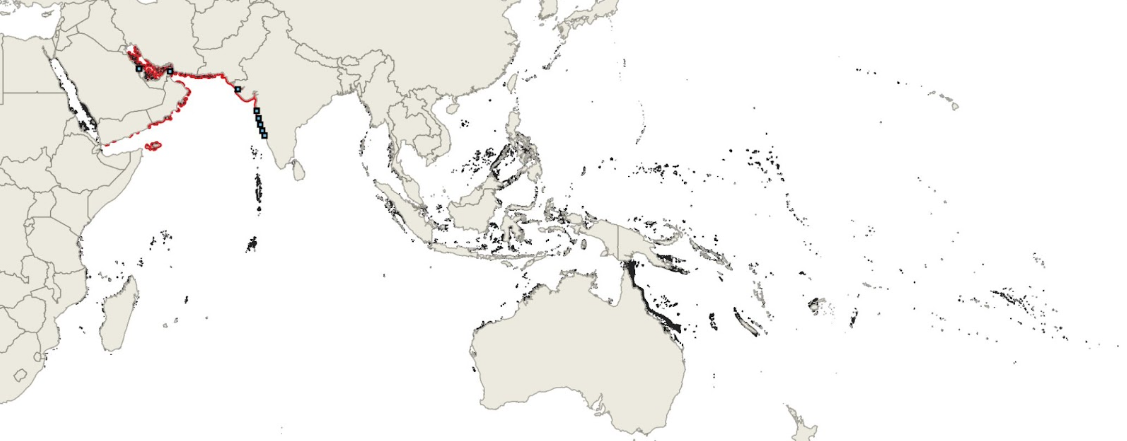
Common Name: Arabian Marbleshrimp
Identification: Carapace & pleon dull in color, with indistinct white spots overlaid by dull-red crenulate blotches dotted with blue. 5th & 6th pleonites similarly patterned. Pereopods yellow with black & blue bands or pale with dull stripes. Maxilliped setae white. Scaphocerite pale or reddish, with incomplete or dotted white stripe on the inner edge, apically with white spots. Basicerite dark, with 2 pale spots. Male 1st pereopod greatly elongated.
Notes: This species shares a similar pattern with the Crenulated Marbleshrimp, but the relative length of the male 1st pereopods appears to differ; it’s unknown if any similar shrimp exists in the intervening areas of the Indian Ocean (Maldives, Andaman Sea, Sumatra & Java).
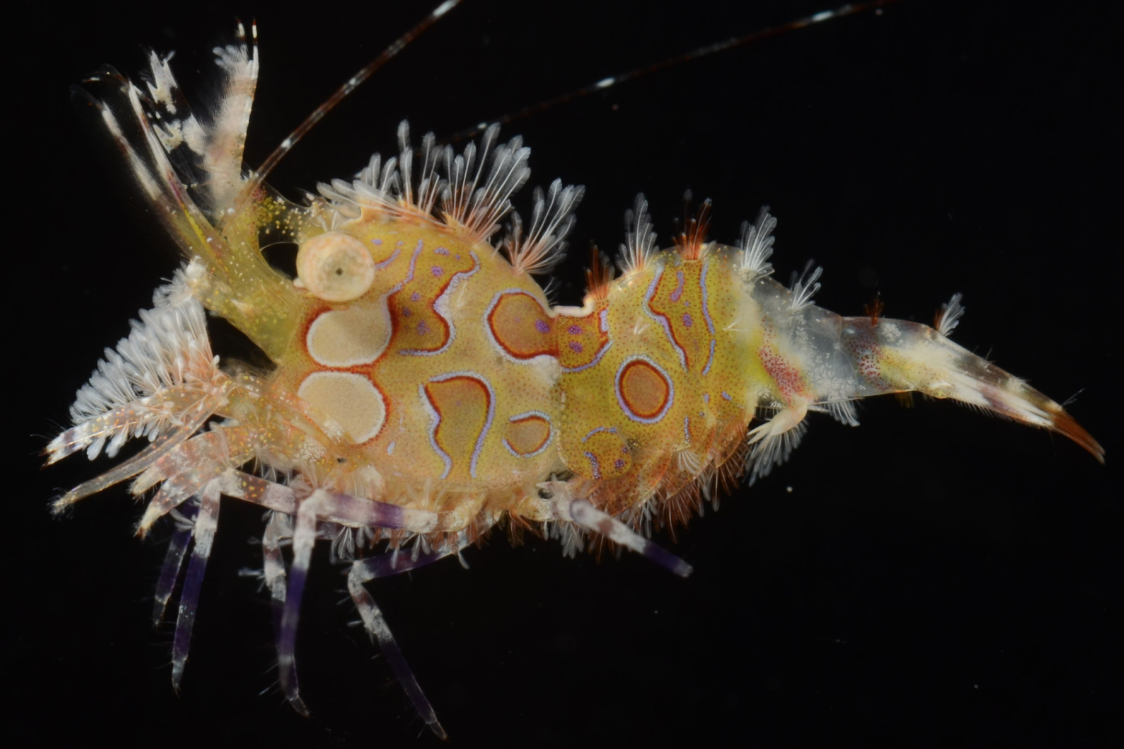
Credit: Millennium Island (Florida Museum of Natural History Invertebrate Zoology)
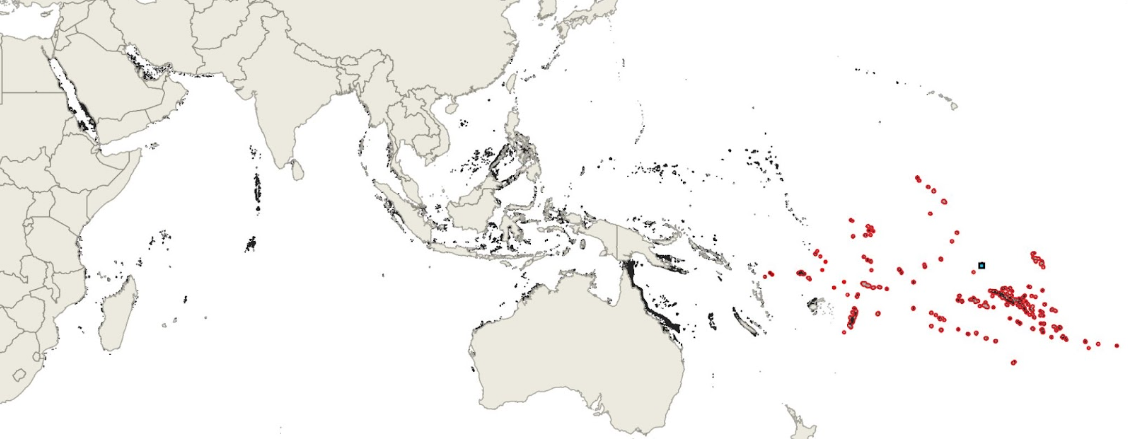
Common Name: Millennium Marbleshrimp
Identification: Carapace yellowish with 2 large pale adjoined spots anteriorly atop a background pattern of 4 irregular multicolored blobs. Pleon yellowish, with similar multicolored blobs. 5th & 6th pleonites with red & white streaks. Uropods red & white. Pereopods white, with purple bands. Maxilliped setae white. Scaphocerite yellow basally, turning white apically with dark markings. Basicerite unpatterned. Male 1st pereopod unknown.
Notes: Known only from 3 subadult specimens collected at Millennium Island, Kiribati.
The neglectus complex
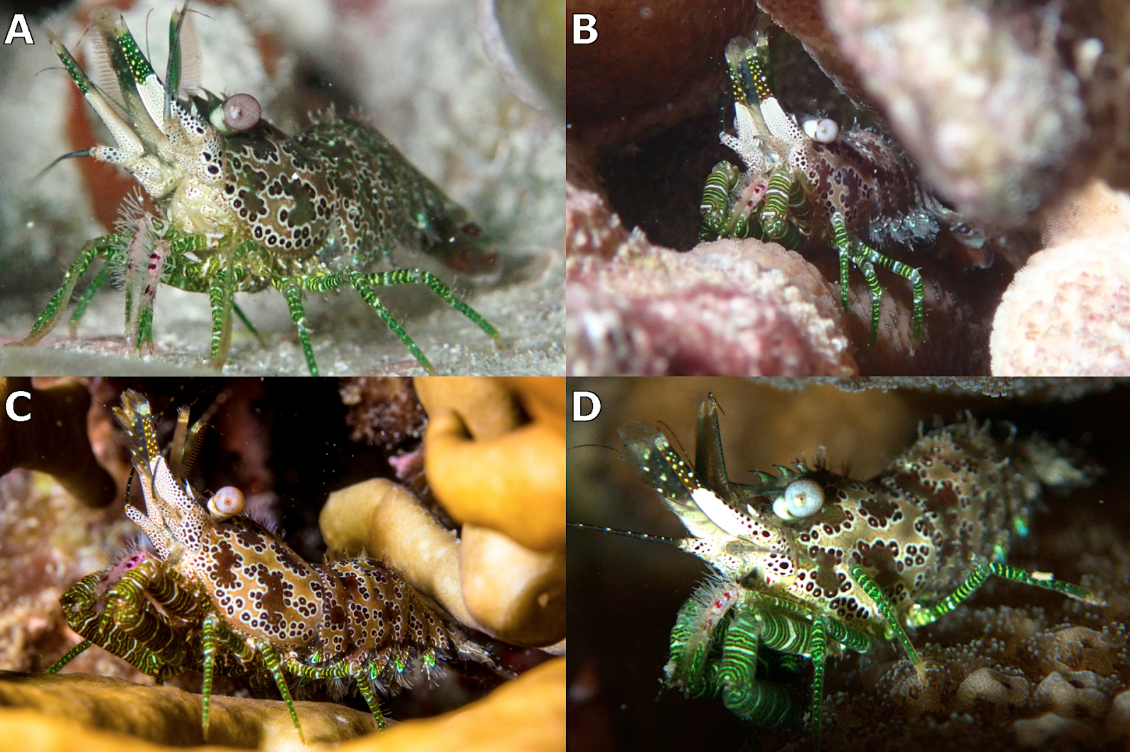
Credit: A: Maldives (Amanda Johnston); B: One Tree Island (Josh Moloney); C: Bali (Frank Spies); D: Moorea (tahiticrabs)
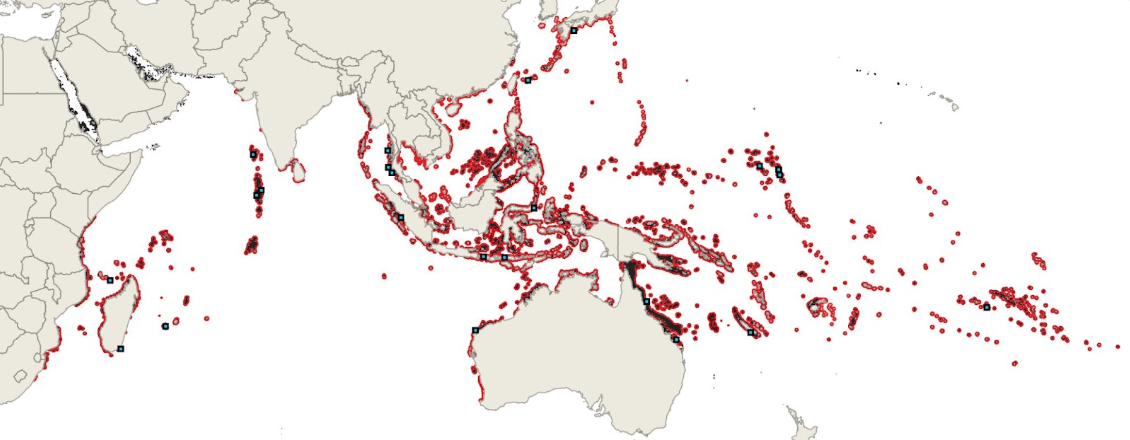
Common Name: Stippled Marbleshrimp
Identification: Carapace and pleon orange with widely separated red blotches ringed by smaller red circles, each with a white margin and white central dot. Pereopods with closely spaced green bands. Pleopods green-tipped. Maxilliped pink, with white setae. Scaphocerite white, with abundant black stipples basally, apically darkened with white & yellow dots. Basicerite white, with numerous red stipples, sometimes with a few larger white-ringed black spots. Male 1st pereopod stout.
Notes: This species has a seemingly disjunct distribution, with very few records from Indonesia and none from the Philippines, though many areas (particularly in Melanesia) remain very poorly documented.
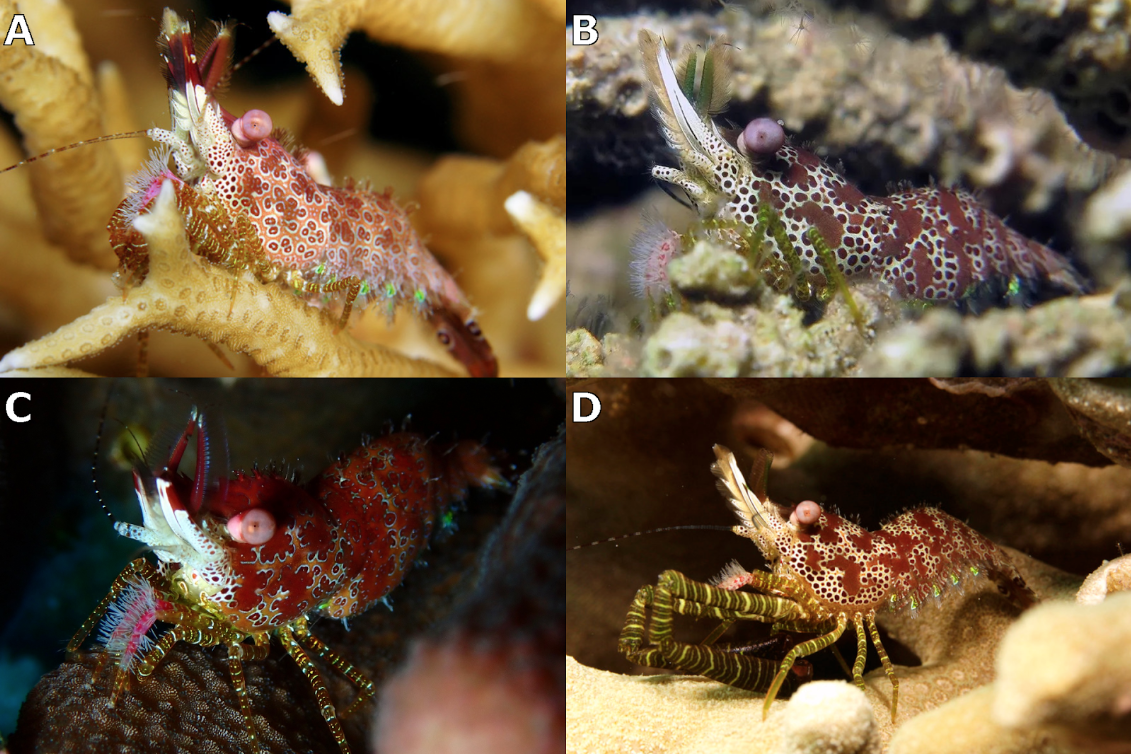
Credit: A: Manado (Brian Mayes); B: Ambon (lazydiving); C: Orchid Island (lanny753); D: Romblon (Wolfgang Holz)
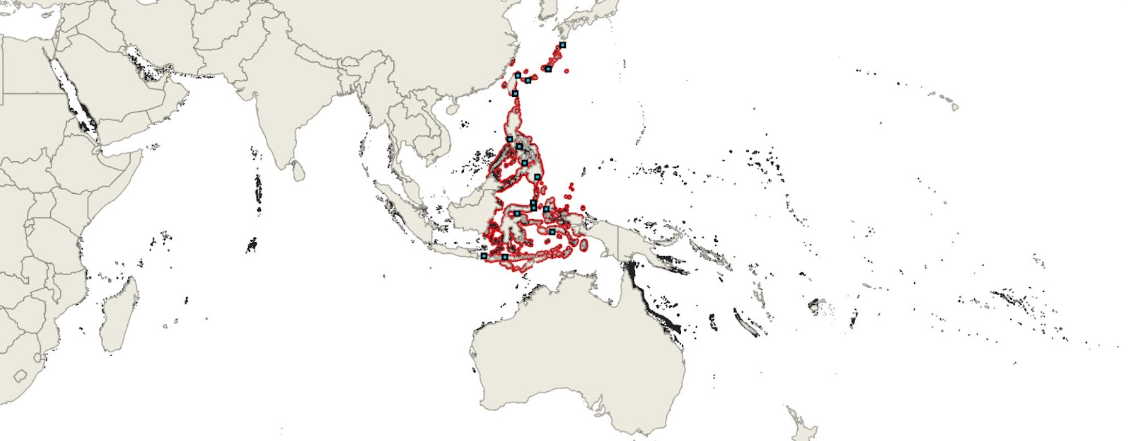
Common Name: Lined Marbleshrimp
Identification: Carapace and pleon orange with widely separated red blotches ringed by smaller red circles, each with a white margin. Pereopods with closely spaced green bands. Pleopods green-tipped. Maxilliped pink, with white setae. Scaphocerite white, with a medial black stripe basally, and with or without apical darkening. Basicerite white, with numerous red stipples, sometimes with a few larger white-ringed black spots. Male 1st pereopod stout.
Notes: This species appears to replace the Stippled Marbleshrimp in much of Indonesia and the Philippines, though the 2 have been seen together in a few locales (Bali, Lembeh). There are consistent differences between populations in Taiwan and Japan (fewer red circles on carapace, each with a white central dot; scaphocerite apically darkened) compared to the Philippines (more red circles on carapace, usually without a white central dot; scaphocerite white apically); however, both of these forms occur in Indonesia. If there are multiple species involved, why would they show allopatry in the north and sympatry in the south?
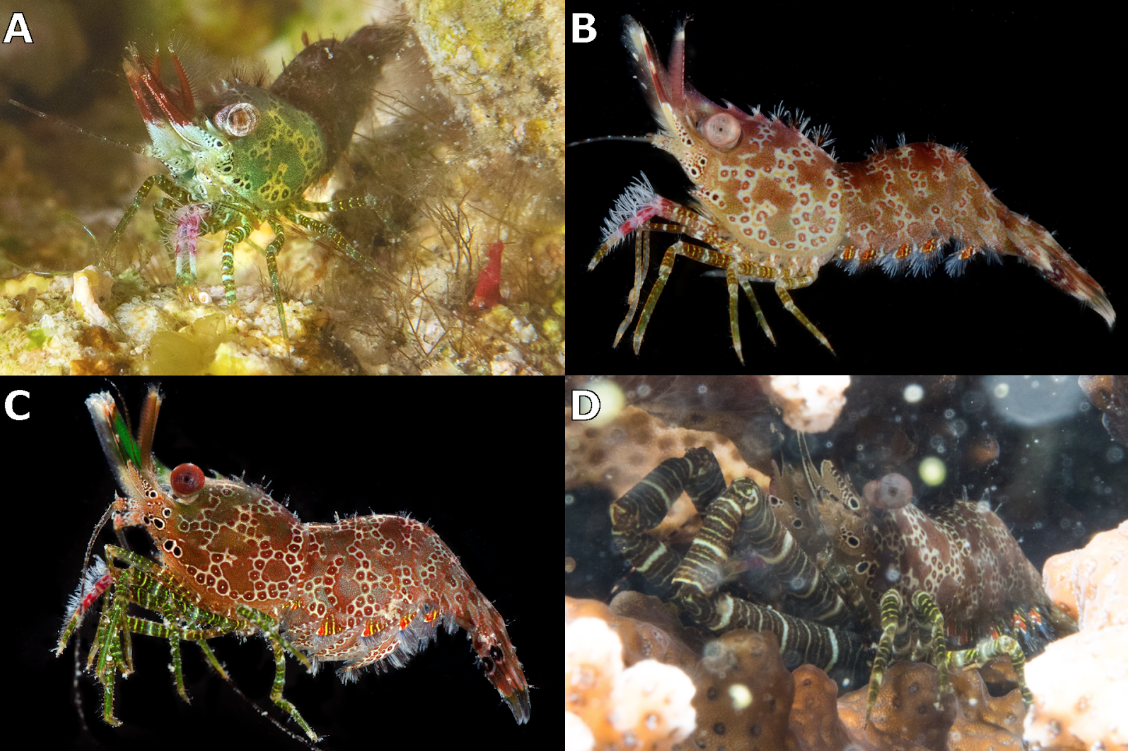
Credit: A: Aqaba (Rafi Amar); B: Jeddah (Florida Museum of Natural History Invertebrate Zoology); C: Oman (lamarine); D: Oman (Florida Museum of Natural History Invertebrate Zoology)
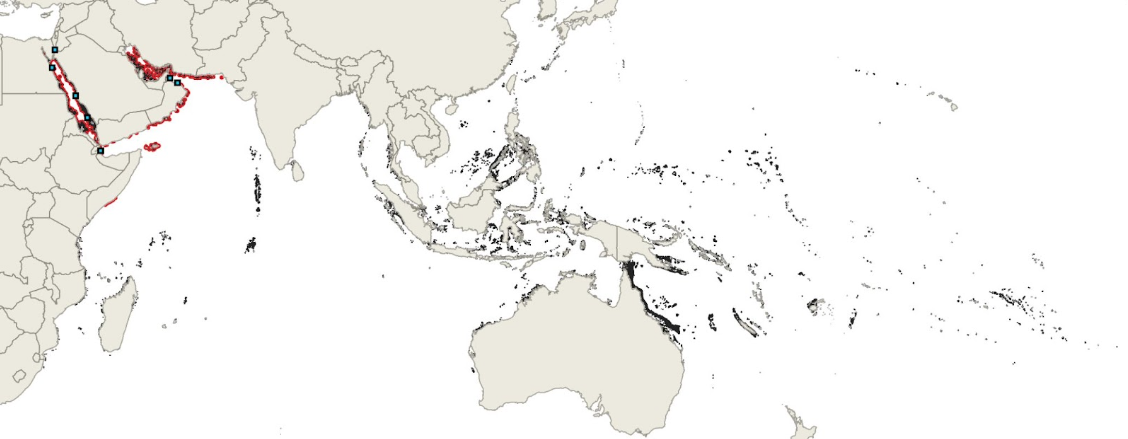
Common Name: Orangetip Marbleshrimp
Identification: Carapace and pleon white with closely spaced red blotches; the interstices are filled with smaller red circles, each with a white central dot. Pereopods with closely spaced green bands. Pleopods orange-tipped. Maxilliped pink, with white setae. Scaphocerite white, with black striations and a single black circle basally on the outer margin, apically darkened, with a single white spot. Basicerite white, with numerous red stipples and 2 white-ringed black spots. Male 1st pereopod stout.
Notes: Though presently known only from the Arabian Peninsula, this species might be expected to occur throughout the Western Indian Ocean.
Credit: A: Kwajalein (Scott Johnson); B: Kavieng (Zden?k ?uriš / MNHN); C: Saipan (Kaeli Swift); D: Saipan (Kaeli Swift)
Common Name: Polkadot Marbleshrimp
Identification: Carapace and pleon orange or green, with widely spaced large red circular spots. Pereopods with closely spaced green bands. Pleopods blue-tipped. Maxilliped pink, with white setae. Scaphocerite white, with red stipples and a single red circle basally on the outer margin, apically darkened, with a single white spot. Basicerite white, with numerous red stipples and 3 white-ringed red spots. Male 1st pereopod stout.
Notes: Superficially similar to the Half-spotted Marbleshrimp from the marmotus complex, illustrating a striking example of convergent evolution within the genus.
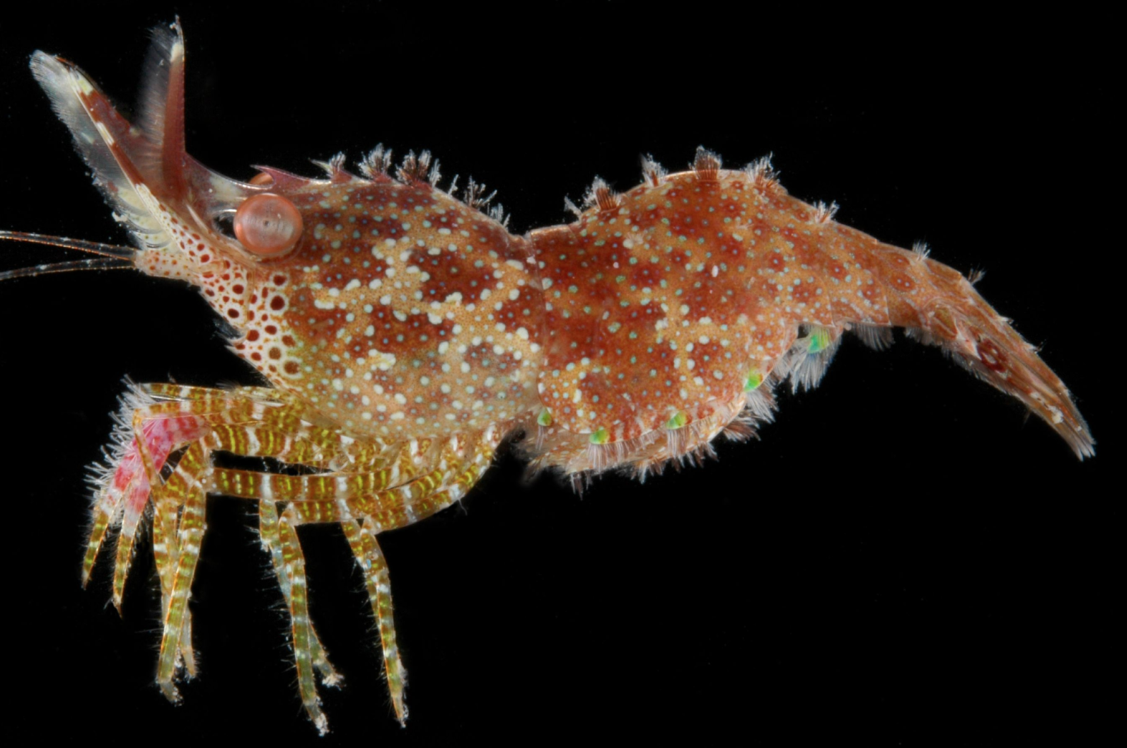
Credit: Heron Island (Florida Museum of Natural History Invertebrate Zoology)
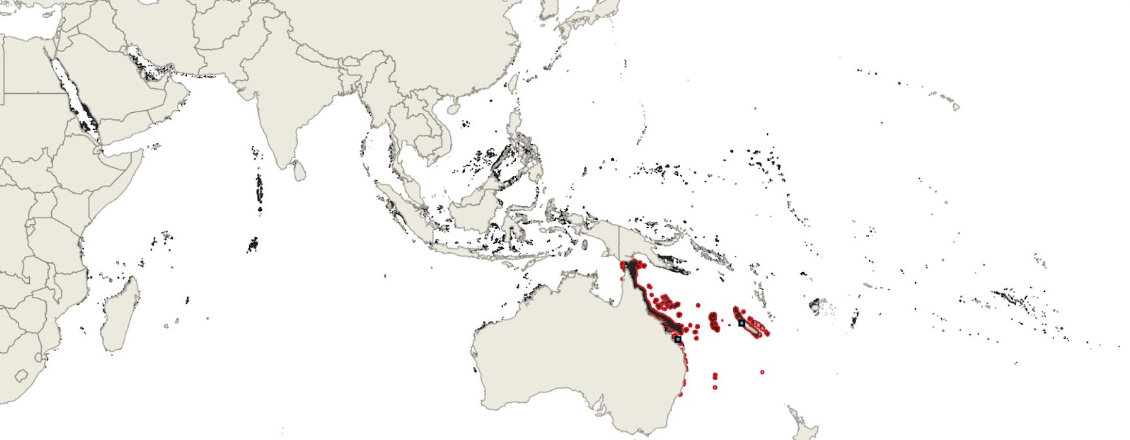
Common Name: White-spotted Marbleshrimp
Identification: Carapace and pleon orange, with indistinct dark blotches surrounded by smaller white spots. Pereopods with closely spaced green bands. Pleopods green-tipped. Maxilliped pink, with white setae. Scaphocerite white, with red stipples and a single black circle basally on the outer margin, apically darkened, with a single white spot. Basicerite white, with numerous red stipples and 3 white-ringed black spots. Male 1st pereopod unknown, but likely stout.
Notes: Known only from the subtropical Coral Sea. Likely a close relative of the Polkadot Marbleshrimp, and superficially similar to the Lord Howe Marbleshrimp from the marmotus complex.
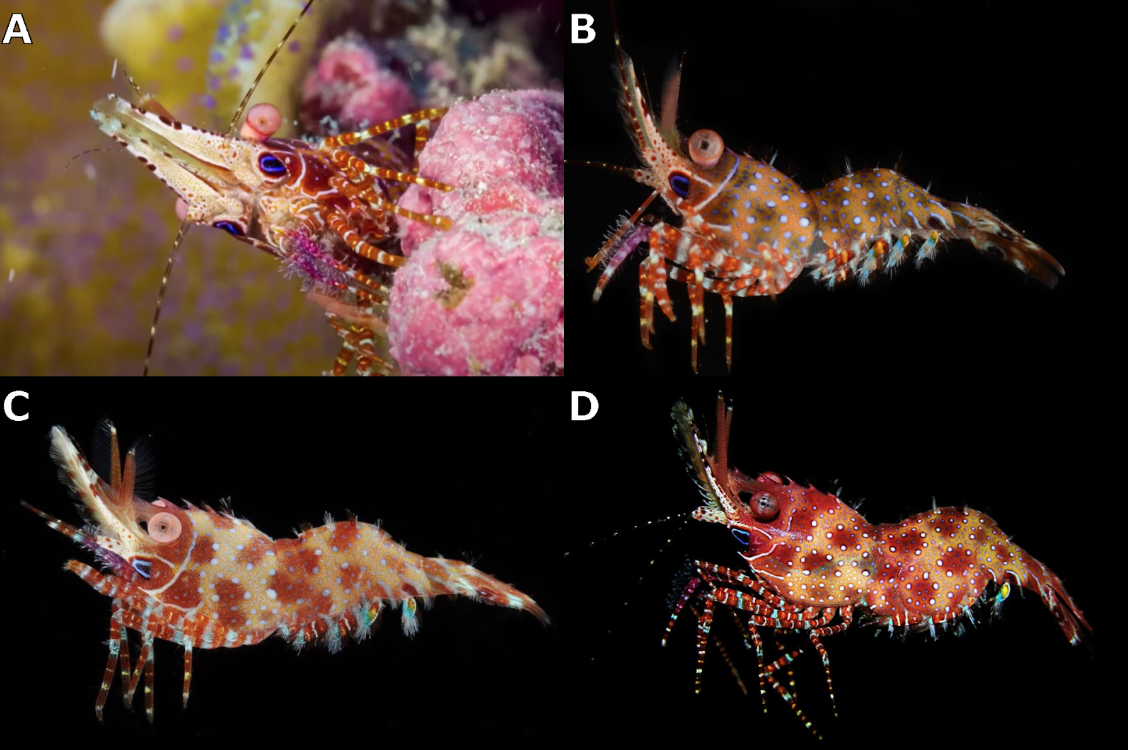
Credit: A: Rawaki (unknown); B: Starbuck Island (Florida Museum of Natural History Invertebrate Zoology); C: Moorea (Florida Museum of Natural History Invertebrate Zoology); D: Moorea (Florida Museum of Natural History Invertebrate Zoology)
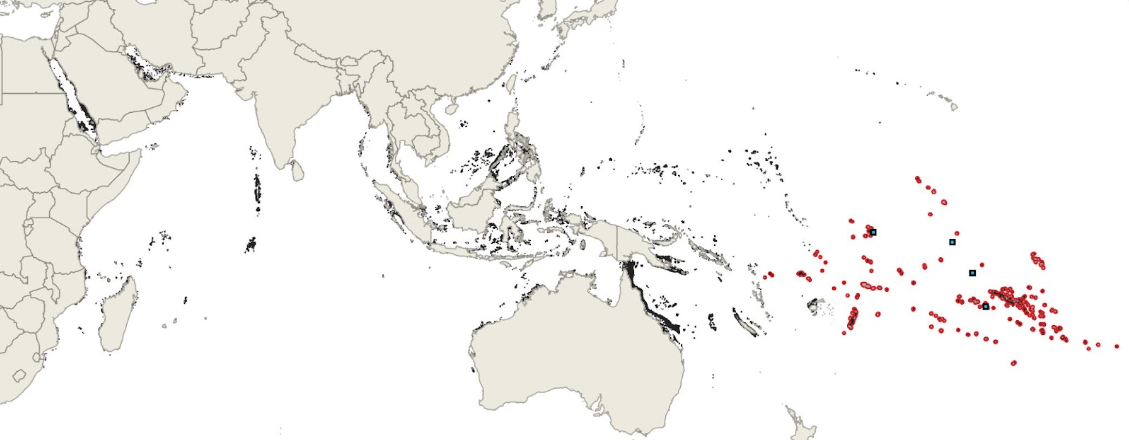
Common Name: Polynesian Marbleshrimp
Identification: Carapace and pleon orange, with indistinct red blotches surrounded by smaller white spots and dots; a white semicircular line is present anteriorly, plus 2 shorter white lines below the eye and above the maxillipeds. Pereopods with red bands. Pleopods turquoise-tipped, with orange and red bands. Maxilliped pink, with white setae. Scaphocerite white, with red stipples and large red markings apically along the margins. Basicerite red, with a black & blue ocellus. Male 1st pereopod unknown, but likely stout.
Notes: This distinctive species is the only member of the neglectus group lacking green-banded legs.
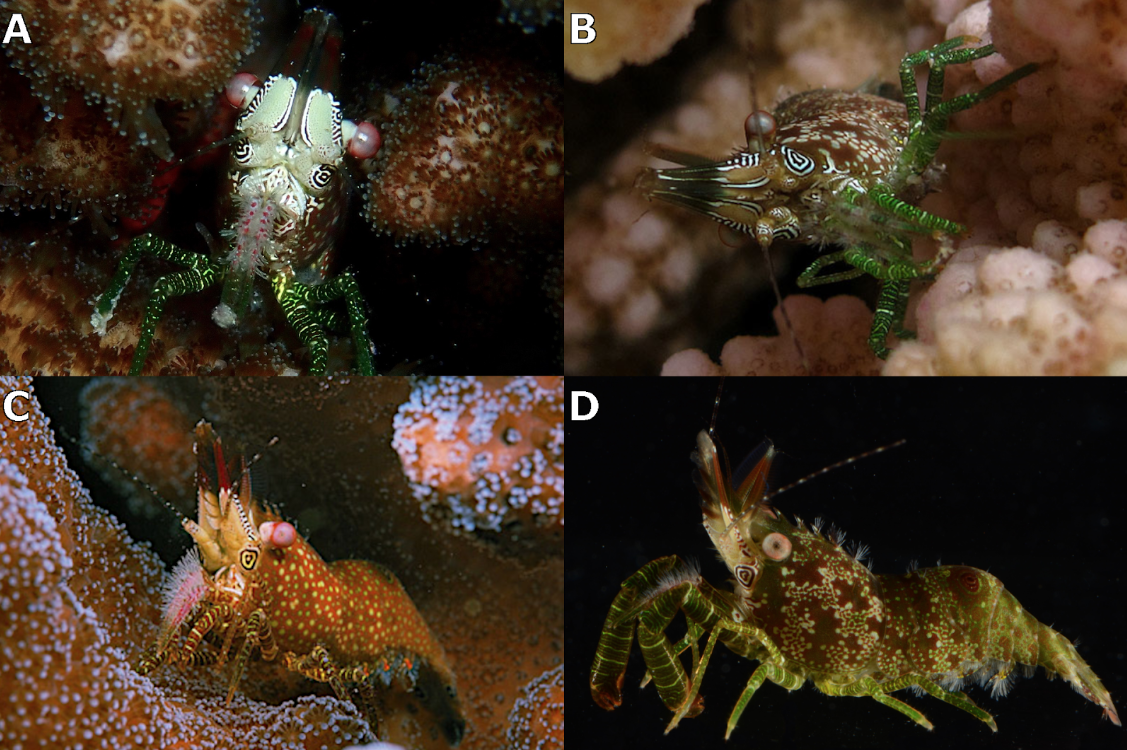
Credit: A: Besar (Amanda Johnston); B: Reunion (Philippe Bourjon); C: Kashiwajima (S. Nakayama); D: New Caledonia (Zden?k ?uriš / MNHN)
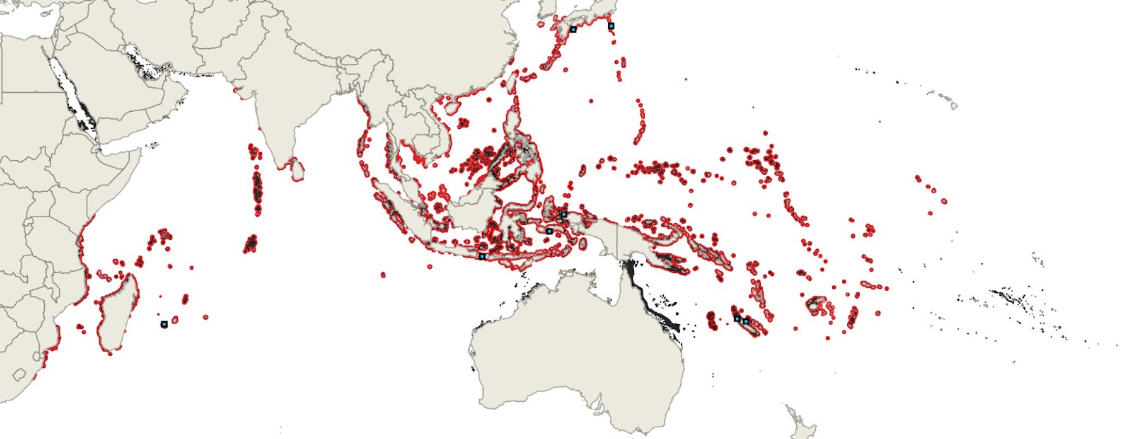
Common Name: Bullseye Marbleshrimp
Identification: Carapace and pleon dull red, with or without indistinct red blotches, and with white spots, vacuoles, or reticulations (depending on the relative development of the red pigmentation). 3rd pleonite with a prominent pair of dark ocelli. Pereopods with closely spaced green bands. Pleopods orange-tipped. Maxilliped pink, with white setae. Scaphocerite white, with red striations on the outer margin and a red stripe on the inner margin, apically red, without a white spot. Basicerite with concentric red & white circular markings. Male 1st pereopod stout.
Notes: This is a widespread but very poorly documented species. Based on a limited set of observations, there may be geographic differences in the carapace color patterning, hinting at yet more cryptic species.

Credit: A: North Solitary Island (Bob Edgar); B: Lord Howe Island (David Rolla)
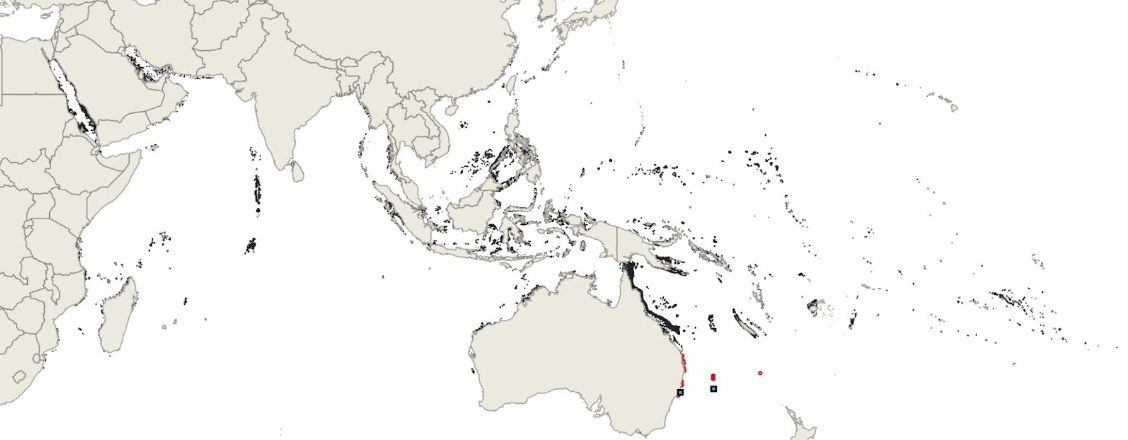
Common Name: Southern Marbleshrimp
Identification: Carapace and pleon dull red, with distinct red blotches surrounded by white lines and dots. 3rd pleonite with a prominent pair of dark ocelli. Pereopods with closely spaced green bands. Pleopods blue-tipped. Maxilliped pink, with white setae. Scaphocerite yellow, with red & white stripes on the outer margin and a red stripe on the inner margin, apically red, without a white spot. Basicerite with concentric red & white circular markings, the centermost being white. Male 1st pereopod unknown, but likely stout.
Notes: Very similar to the Bullseye Marbleshrimp, but diagnosed by differences in the scaphocerite and subtleties of the carapace patterning. Restricted to a narrow subtropical distribution, though possibly extending eastward to Norfolk Island, Kermadec, the Austral Islands, and Pitcairn.
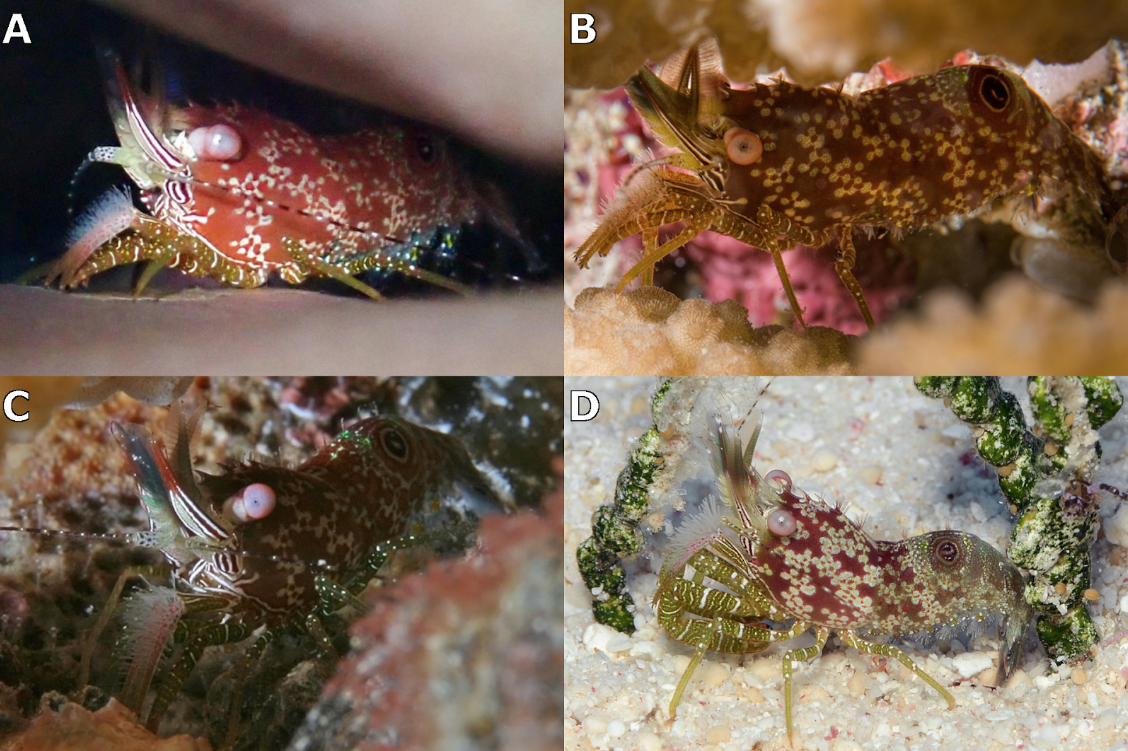
Credit: A: Aur Atoll (Raphael Forns); B: Hawaii (Chuck Babbitt); C: Moorea (Thomas Vignaud); D: Kwajalein (Scott Johnson)
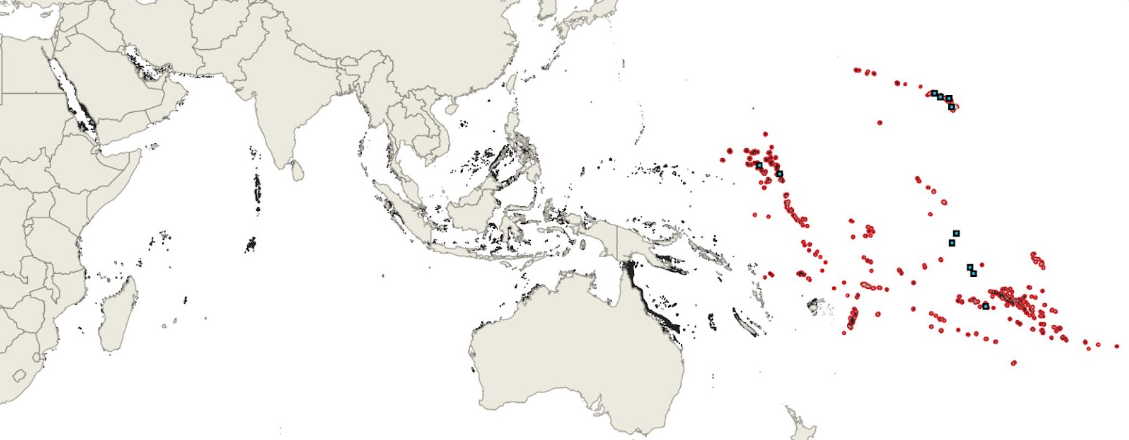
Common Name: Striped Marbleshrimp
Identification: Carapace and pleon with indistinct red blotches surrounded by tessellated white spots. 3rd pleonite with a prominent pair of dark ocelli. Pereopods with closely spaced green bands. Pleopods darkly colored, with a small white tip. Maxilliped pink, with white setae. Scaphocerite white, with red & white stripes on the outer margin and a red stripe on the inner margin, apically red, without a white spot. Basicerite with concentric red & white oblong markings, the centermost being red. Male 1st pereopod stout.
Notes: Closely related to the Bullseye and Southern Marbleshrimps, all of which have ocelli on the 3rd pleonite and the basicerite. This species is well-documented in Hawaii, but less well-known elsewhere in the Central Pacific.
Saron inermis
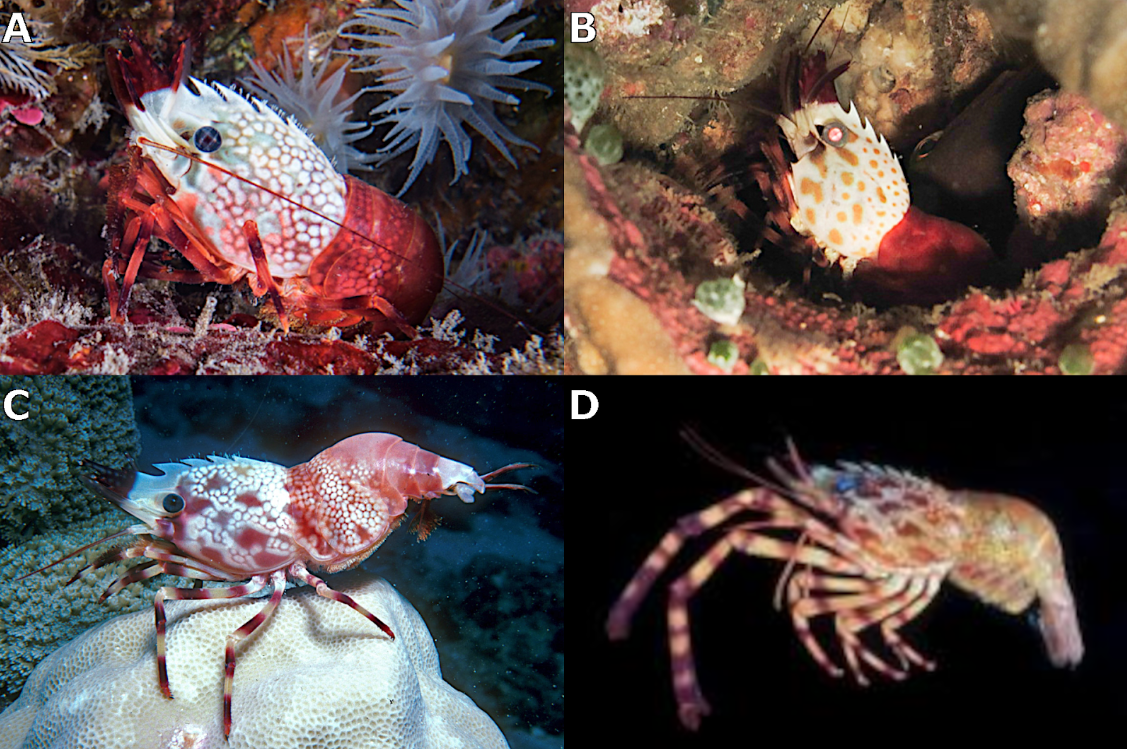
Credit: A: Reunion (Eric Vingerhoedt); B: Anilao (somewake1); C: Kwajalein (Scott Johnson); D: Okinawa (somewake1)
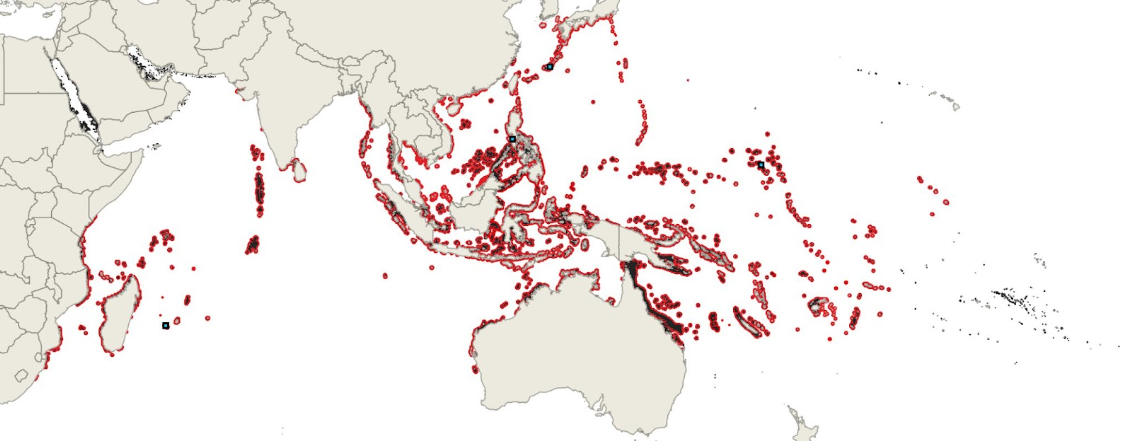
Common Name: Sawtooth Marbleshrimp
Identification: Carapace white, with oblong dark spots or with white vacuoles at night; carapace teeth are large and with sparse setae, giving a distinctly sawtooth appearance. Pleon dusky and finely spotted, turning bright red at night. Pereopods white or yellow, with thick blue bands. Maxilliped with short inconspicuous setae. Scaphocerite and rostrum red. Basicerite red. Male 1st pereopod greatly elongated.
Notes: A rarely encountered species, despite its robust appearance and wide range. Reported from shallow reefs in Japan, but, as with most of the Saron shrimps, little is known of its ecology or behavior.
Saron rectirostris
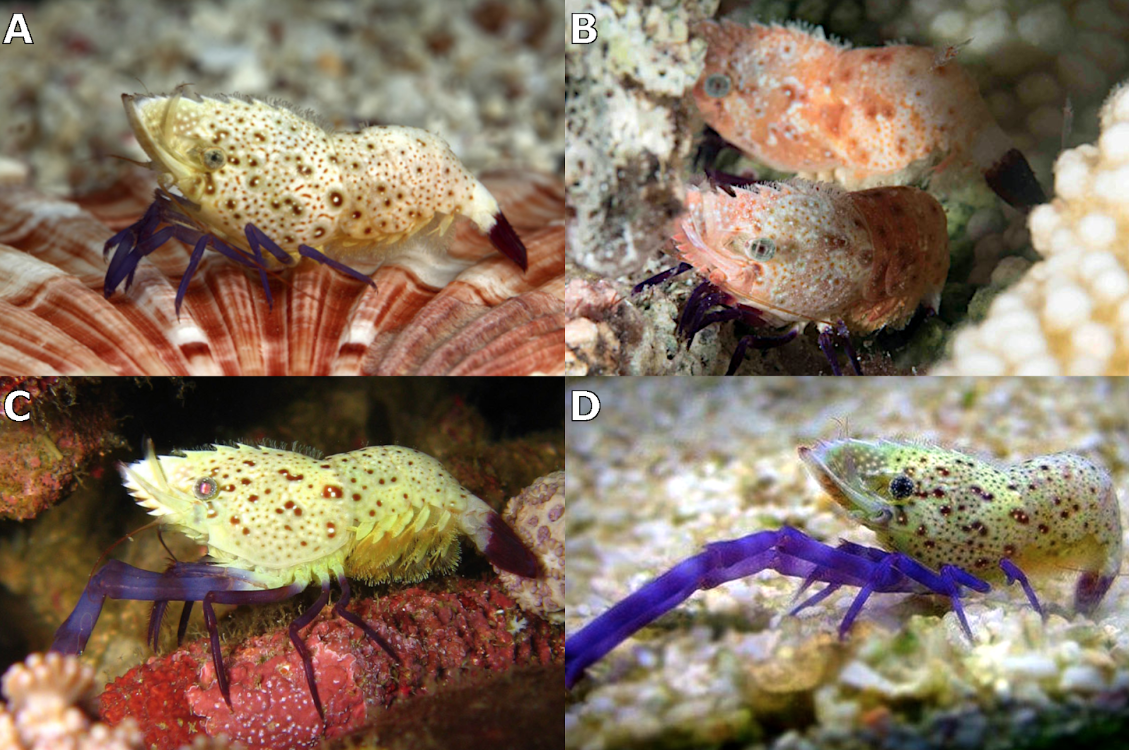
Credit: A: Indonesia (Christopher Zarnick); B: Jay Ryan (Kwajalein); C: Puerto Galera (Sylvain Le Bris); D: aquarium (unknown)
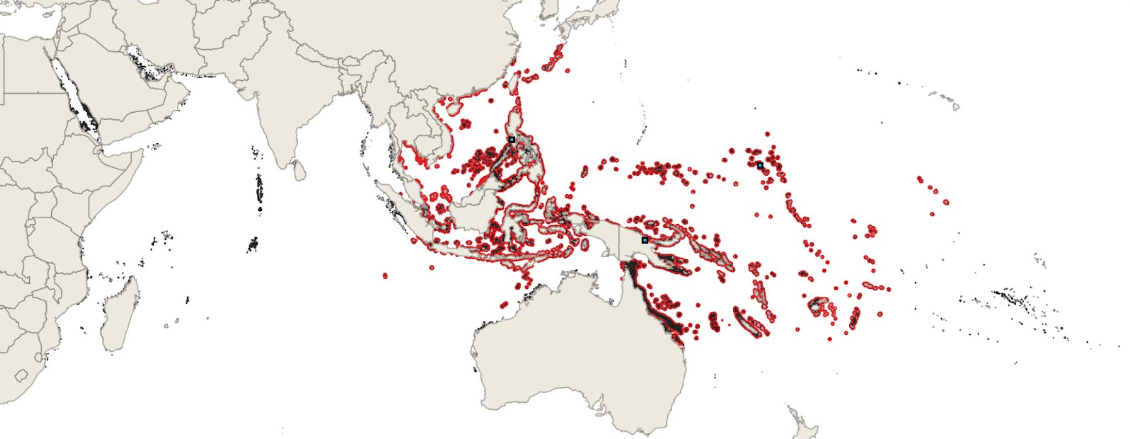
Common Name: Purple-legged Marbleshrimp
Identification: Carapace and pleon white, with fine red spots and dots; carapace teeth slender, with sparse setae. Pereopods purple. Maxillipeds purple, with short inconspicuous setae. Scaphocerite and rostrum white. Basicerite white. Male 1st pereopod greatly elongated.
Notes: An unmistakable species known from very few locations.
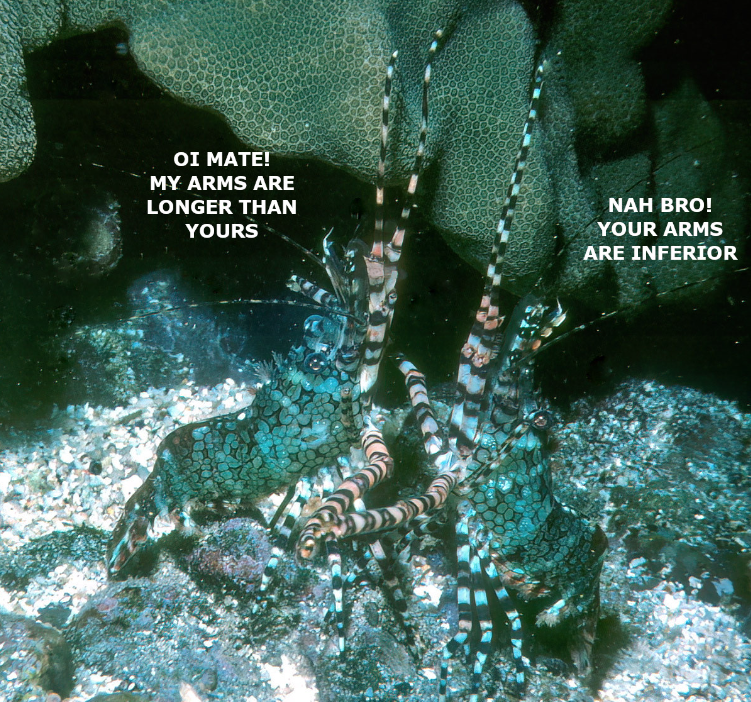
Credit: Hawaii (Scott Johnson)
REFERENCES
Baeza, J.A., Prakash, S., Frolová, P., ?uriš, Z. and Anker, A., 2023. Unweaving a hard taxonomic knot in coral reef dwellers: integrative systematics reveals two parallel cryptic species complexes in ‘marbled’ shrimps of the genus Saron Thallwitz 1891 (Caridea: Hippolytidae). Coral Reefs, 42(1), pp.157-179.
Main image credit: Exmouth, Western Australia (Kristin Anderson)
About the author
Joe Rowlett is the author of Indo-Pacific Corals and studies marine biogeography and speciation. He is a former aquarist and has written extensively for aquarium publications.


